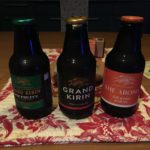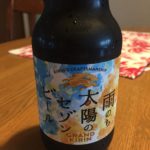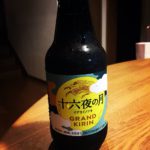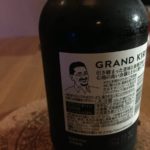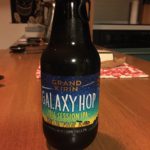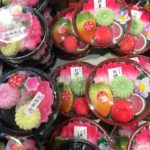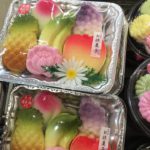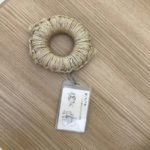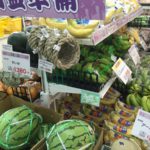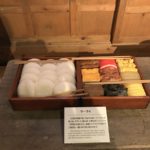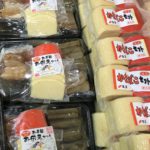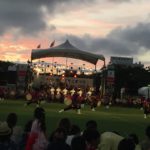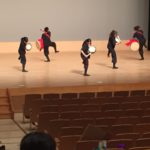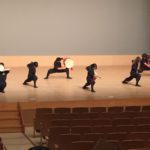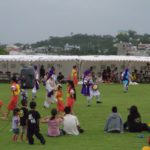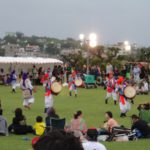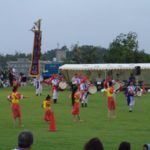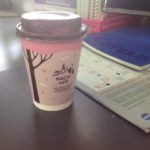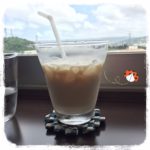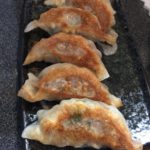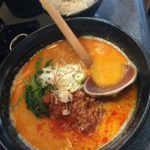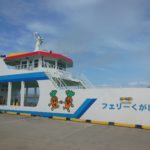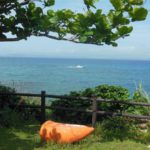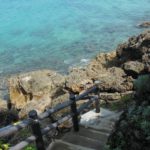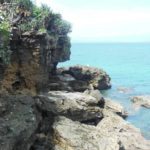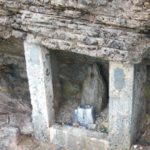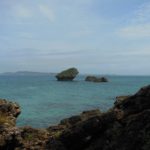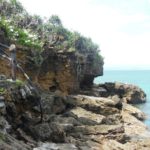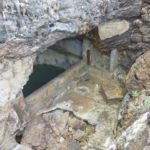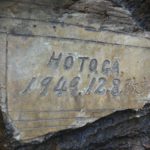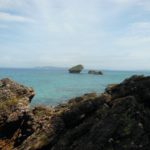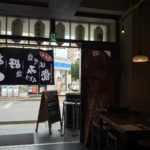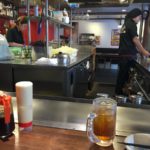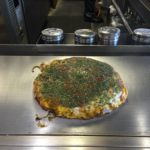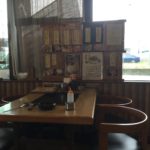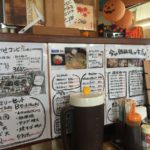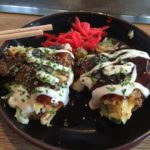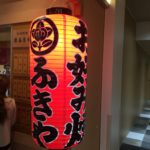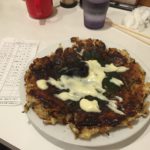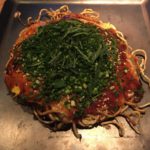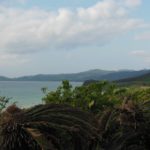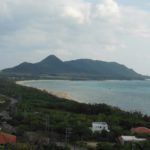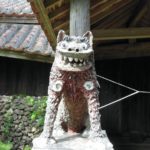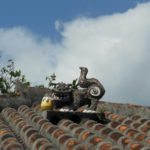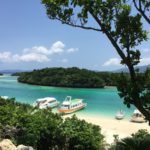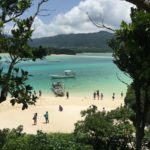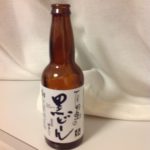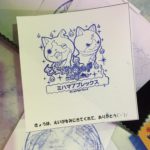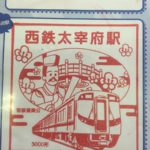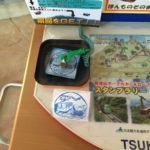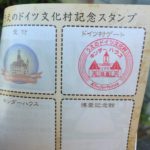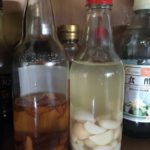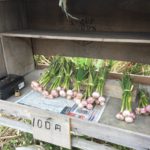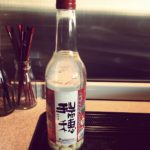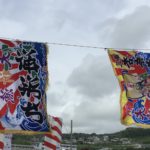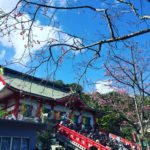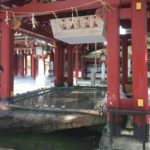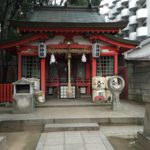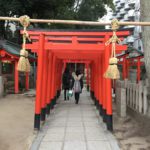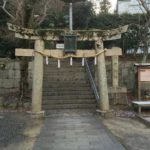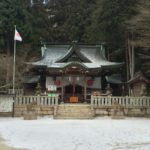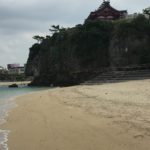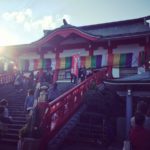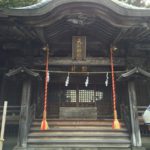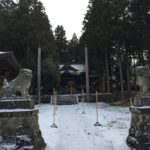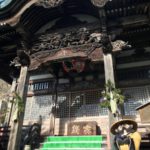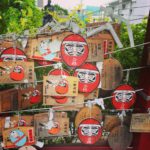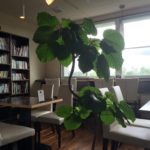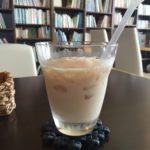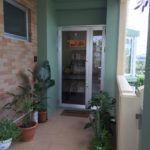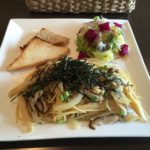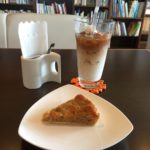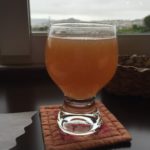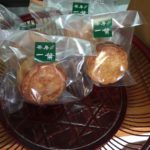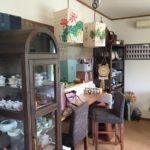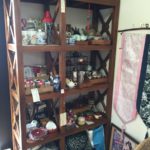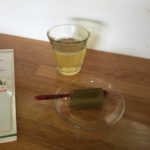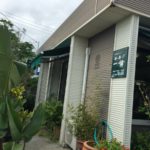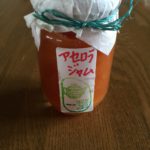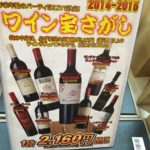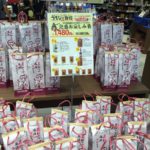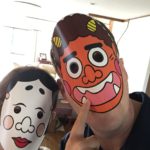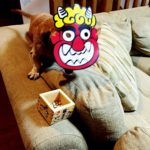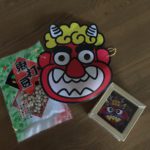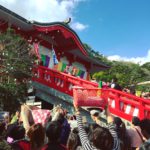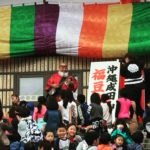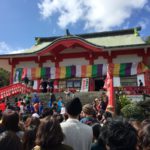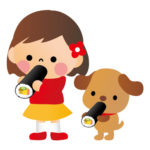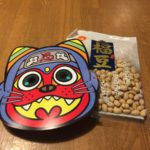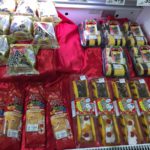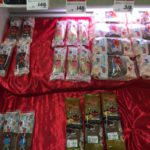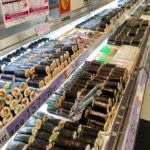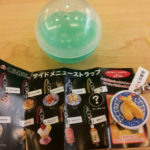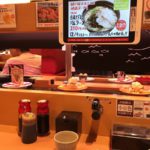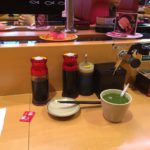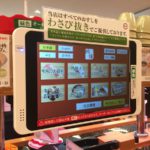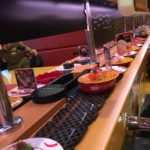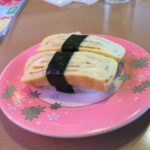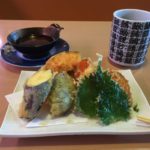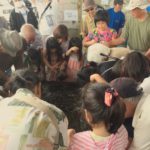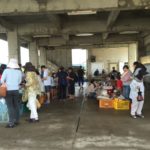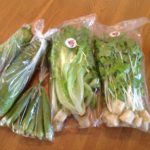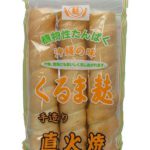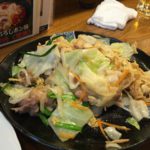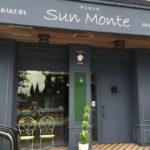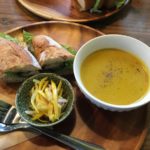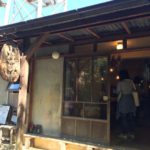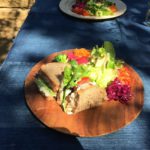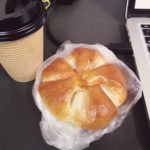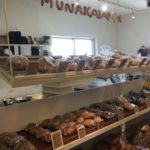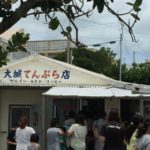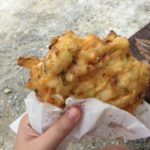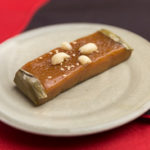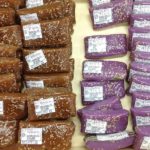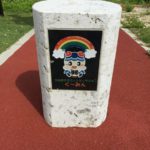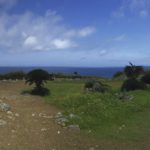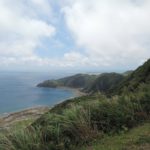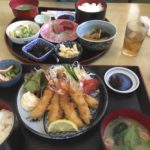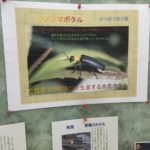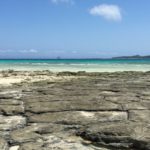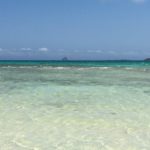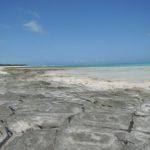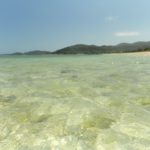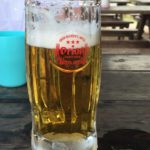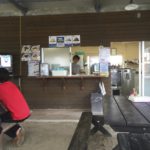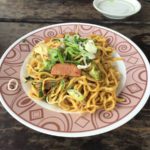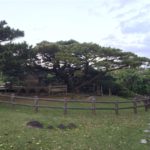Grand Kirin is a line of “craft” type beers that are produced by Kirin beer company. They come in glass bottles and the labels look classier than the average Kirin beer. Sort of hipster, really. These beers are a bit pricier than the regular beers, but overall I do like the taste better. Luckily, my local FamilyMart carries them, so they are pretty easy to find. Anyway, they have many limited release beers that I have been tracking through the year; I was especially interested in the moon-watching beer that was available in September. Unfortunately, most are limited release and only available for a few months at most, but the good news is that means they release new ones to try. I have probably tried all of them, but keep forgetting to take pictures… I guess this means I need to go out and grab a few more beers. This is an initial sampling:
御盆 Obon in Okinawa is often referred to as “kyuubon” 旧盆, which means “old Bon” because it is celebrated according to the lunar calendar (7th lunar month, 13th through 15th days 旧暦7月13日-15日). Some other areas in Japan celebrate it either in July or August 13-15th. It is also called “Shichiguachi” しちぐぁち, meaning 7th month in Okinawan language. It should also be noted that different areas of the Ryukyu islands actually have their own names and traditions for Obon (for instance, Ishigaki-jima and the Yaeyama islands have something interesting called “Angama”); the ones I write about are the most common for Okinawa main island. Many Obon traditions and customs observed in Okinawa are quite different from the ones typically seen on mainland Japan. Something important to note: the Japanese custom of toro nagashi 灯籠流し is not a common practice in Okinawa, so you will not see candle-lit lanterns released afloat on the water during Obon like you might in parts of mainland Japan.
Obon is a custom to commemorate one’s ancestors; the spirits return to this world for 3 days to visit family. It is sometimes referred to as “ghost festival,” “lantern festival,” or “festival of souls” in English.
In 2018, Obon will be on Aug 23-25th and Tanabata will be Aug 17th.
There are 3 days of Obon in Okinawa:
ウンケー unke/unkeh (お迎え): 1st day, welcoming day, when the sun sets. This is the day where families usually visit graves and welcome the ancestors home. Families will gather at the eldest son’s residence (where the family altar, a butsudan 仏壇, is kept). The family altar is set up, and offerings of fruit, mochi, sweets, sake/awamori, beer, and stalks of sugarcane are placed. The sugarcane is left as walking sticks for the spirits walking from the heavens. Obviously the ancestors favorite foods are also usually placed. Lanterns are set up to guide ancestors home.
ナカビ or ナカヌヒ nakabi or nakanuhi (中日): 2nd day, the middle day. On this evening, all my neighbors leave their doors and windows open, and have a large family dinner. The doors and windows are open to allow the ancestors to enter the home. Also, I see a lot of people distributing “gifts” (known as 御中元 ochuugen) on this day (mostly these are random food and household item gift sets sold in department and grocery stores all over), but any day leading up to or during Obon seems to be okay for distributing summer gifts. The eldest son’s family is in charge of the altar, so they must stay at home to receive other family members and visitors; so while the eldest son’s wife has to prepare many foods and the altar for Obon, they also receive many “gifts” in return, usually in the form of rice, beer, laundry soap, etc. For those family that are not the eldest child, instead they must prepare gifts and visit everyone else’s home where the altars are kept. So either way, it is sort of an expensive endeavor.
ウークイ uukui/ukui (御送り or 精霊送り): 3rd day, farewell day. This last day of Obon is filled with music and eisa (Okinawan bon dance), to say farewell to the ancestor spirits and escort them back to the heavens. There is usually a big feast late into the night, with various foods that are offered and special paper money called uchikabi ウチカビ is burned as for the ancestors so that they can use it in the spirit world. Some offerings and sugar cane is left out by the gate/fence/side of the road for the spirits to take home. This day, on the hillside by my village, you can see a large kanji lit up (they use electric lights, not actually burning into a mountain like Japanese tradition). Maybe this year I can get a decent picture of it; it represents some sort of farewell to the dead.
Before Obon, is Tanabata 七夕. In Okinawa, rather than celebrate star festival, it is more common that this is a grave-cleaning day to prepare for Obon and to ask ancestors to come visit during Obon season. It is believed that the ancestors protect their descendants in the real world, so it is important to take of them in their afterlife.
For the butsudan 仏壇 (altar) set up, many things are included. I will explain what is common in Okinawa… probably places in the mainland are a bit different, though some things will be the same or similar.
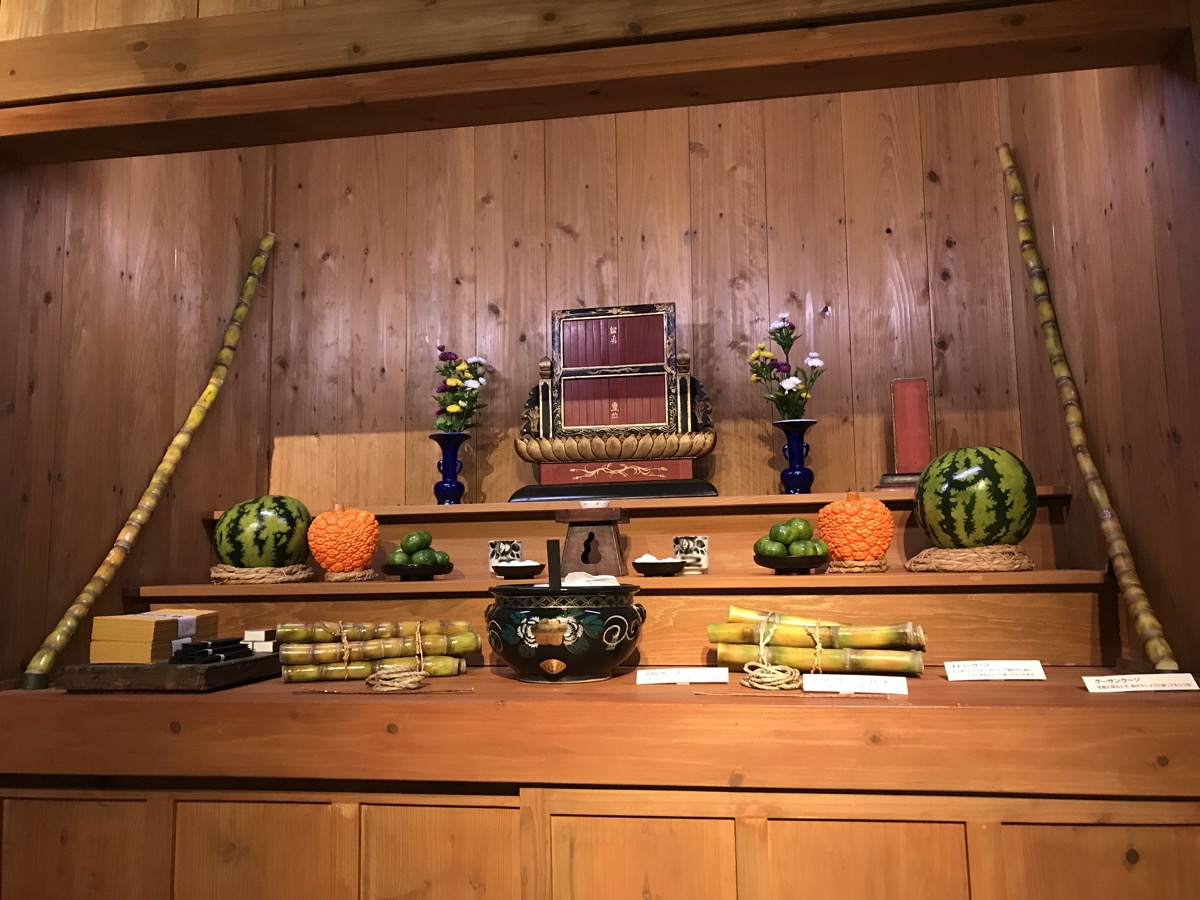
rakugan 落雁: this is dried “sweets” pressed into a mold (very water soluble so it lasts a long time). Despite the colorful appearance, the taste is very subtle, just a little sugar; since this is for altar offerings it is usually more “starchy” than sugary (made from mizuame 水飴, a glutinous rice starch syrup). These tend to be dry and a bit starchy-sweet in flavor. It is a type of Japanese confection (wagashi 和菓子) called higashi 干菓子, which is dried and has low moisture content. Often these will also be called bongashi 盆菓子 (Obon sweets) or kyo-kashi 供菓子 (or お供え菓子).
sugarcane, uuji ウージ (さとうきび satou kibi in Japanese): set out as walking sticks for the spirits. It can also be used to help ancestors carry souvenirs back to the spirit world. There are 2 types set out: long, guusanuuji グーサンウージ to use as a walking stick and as a balancing pole to carry souvenirs, and short, chitu uuji チトゥウージ also used to help carry back souvenirs. Sometimes the short sugarcane is also used as minnuku ミンヌク (水の子 in Japanese, set out as small offerings to Buddhist gods or to keep out bad spirits).
medohagi メドハギ or soromeshi ソーローメーシ (精霊箸): a type of weedy plant. Chopsticks for the ancestors use. I also read somewhere that this can be set out for purification purposes as well.
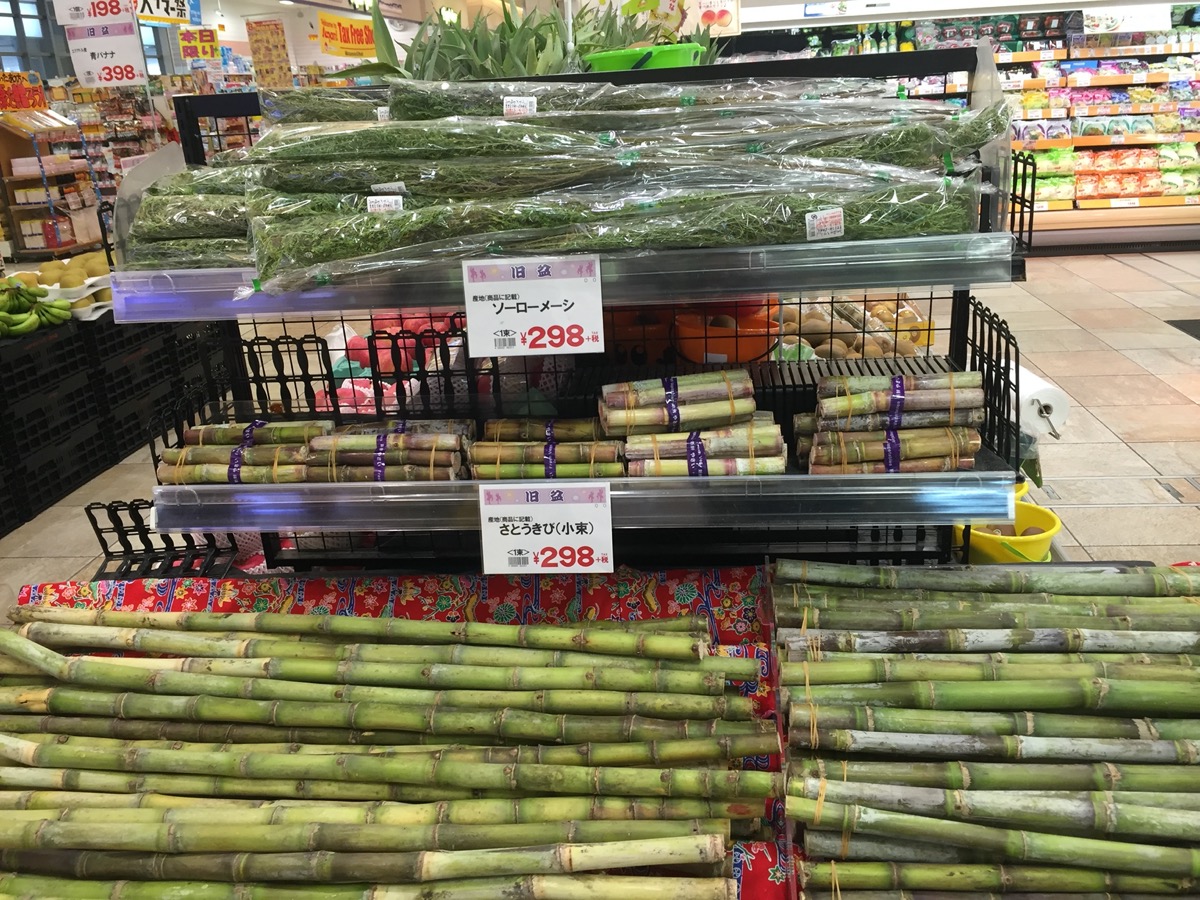
ganshina ガンシナー: circular ropes so your ancestors can take souvenirs (foods) back to the spirit world; they are used to balance foods or gifts on your head. On the altar they are typically displayed by balancing watermelon, pineapple, oranges, etc. on them.
ukui kasa ウークイカーサ: Alocasia leaves. This is apparently used so your ancestors can wrap souvenirs to take back to the heavens.
uchikabi ウチカビ (打紙): Afterlife money! It is a Japanese paper with the design of coins on it. It is burnt on the last day (ukui) so that your ancestors have money in the afterlife.
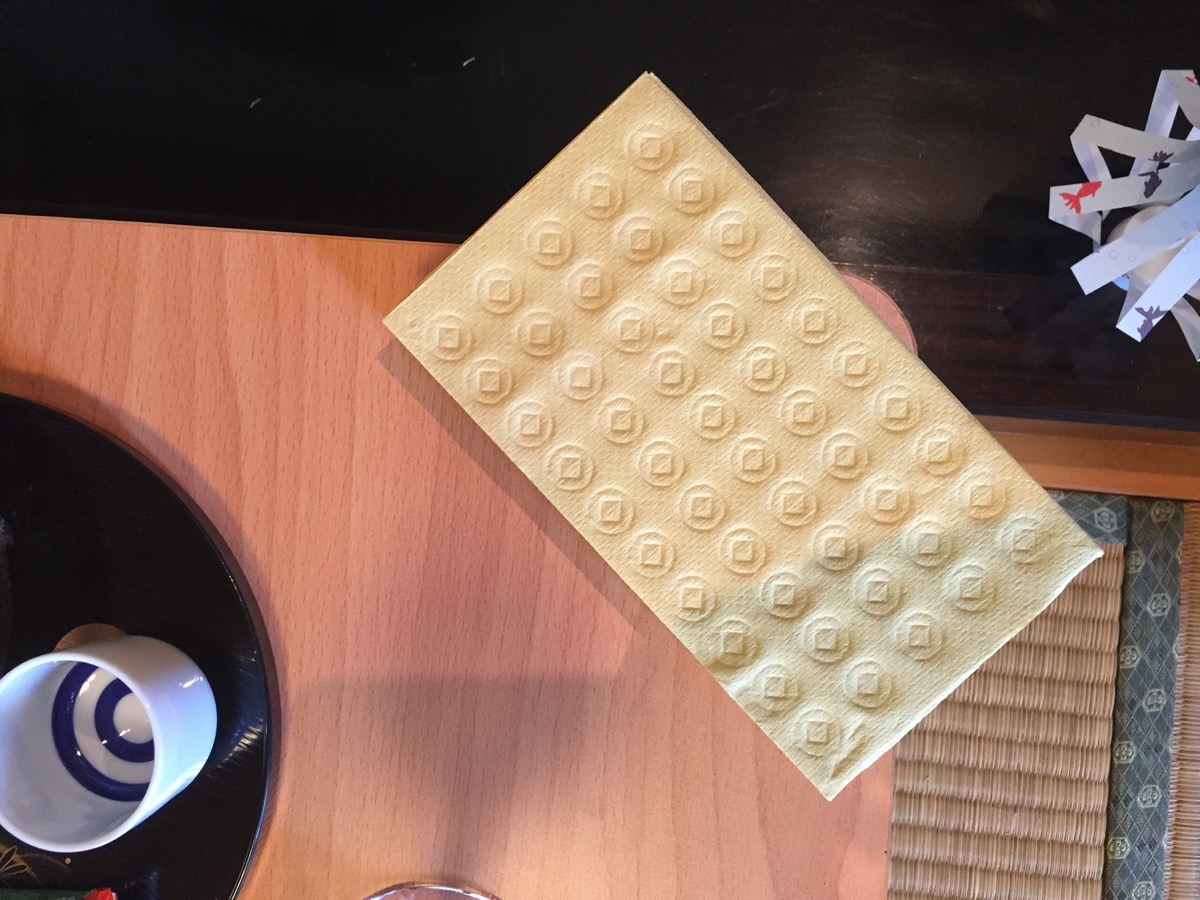
eggplant cow (nasu no ushi ナスの牛) & cucumber horse (kyuuri no uma キュウリの馬): placed outside the home so the ancestors can ride on them from the spirit world home, then placed on the altar on the first day of Obon. This is actually more of a mainland thing than Okinawa, instead here uses the sugarcane since it seems Okinawa ancestors come on foot. In Okinawa, you may even see a variation using a goya ゴーヤー. With them is placed mizunoko 水の子, washed rice with diced cucumber and eggplant; although this is optional, it is supposed refresh returning spirits after their journey.
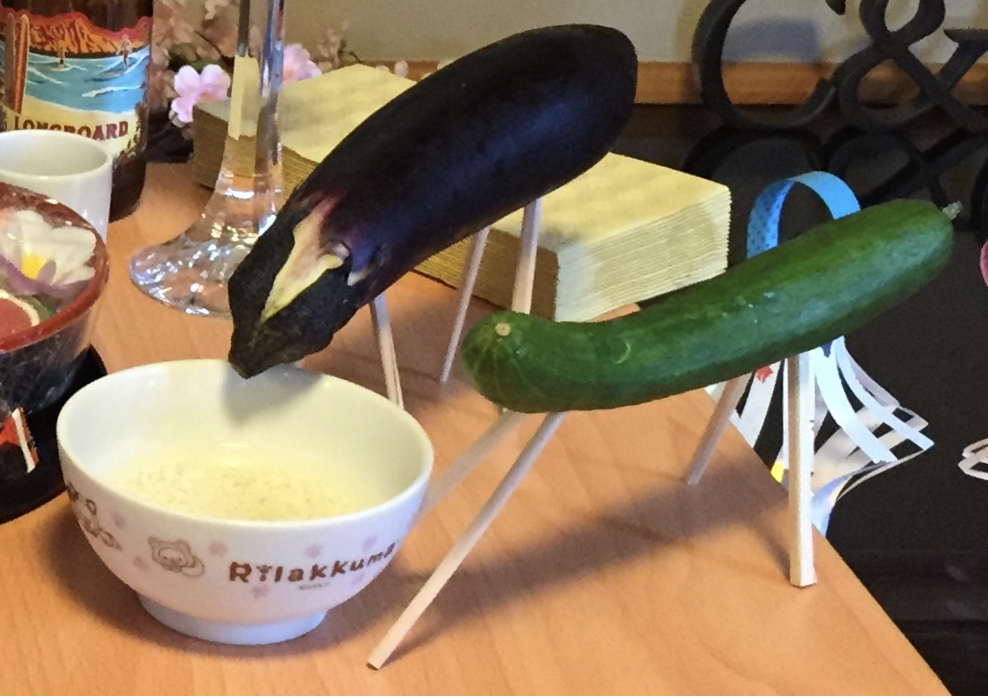
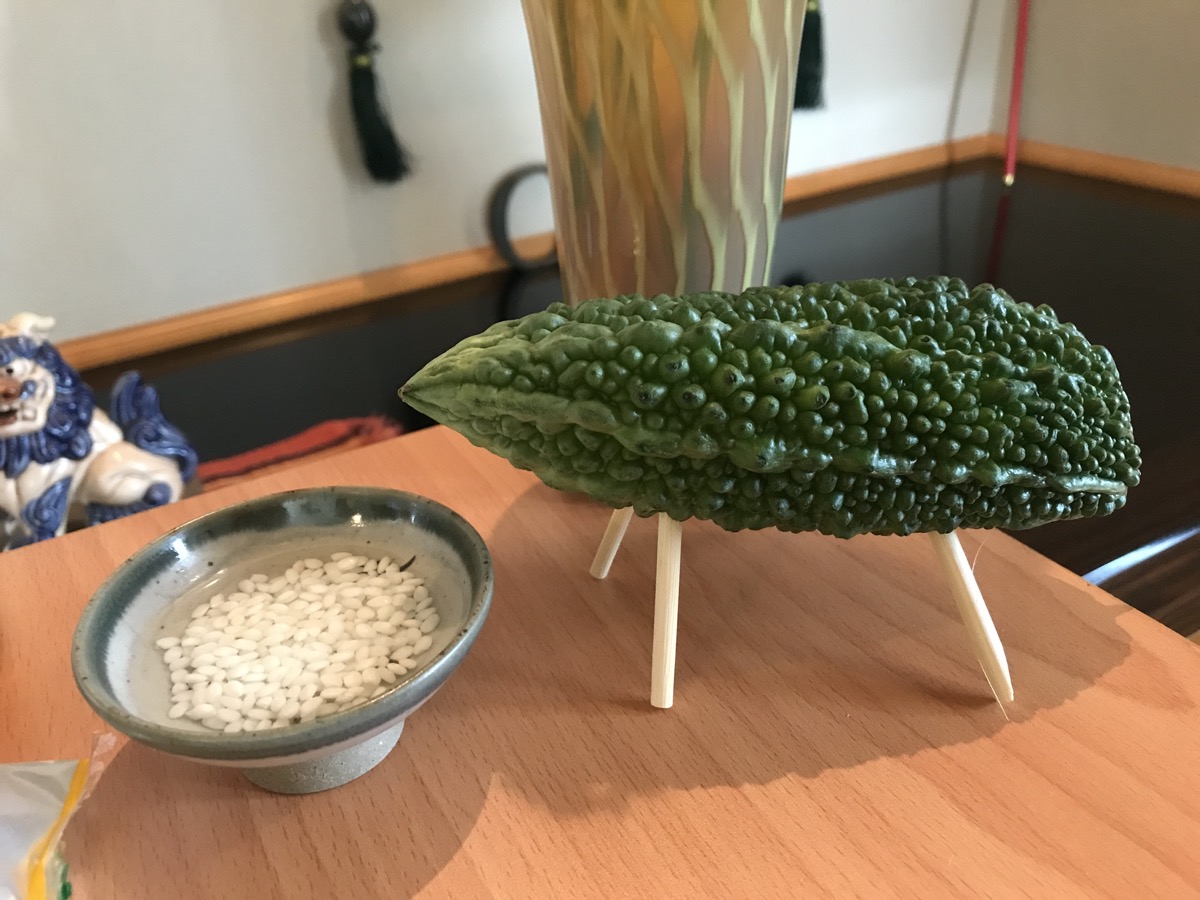
somen そうめん: somen (noodles) are usually place on the altar as well. I don’t know why exactly, but the theory seems to be because somen is easily used in summer cooking, so it is convenient. I also hear it is to use as reins for the ancestors to ride the animals back to the spirit world.
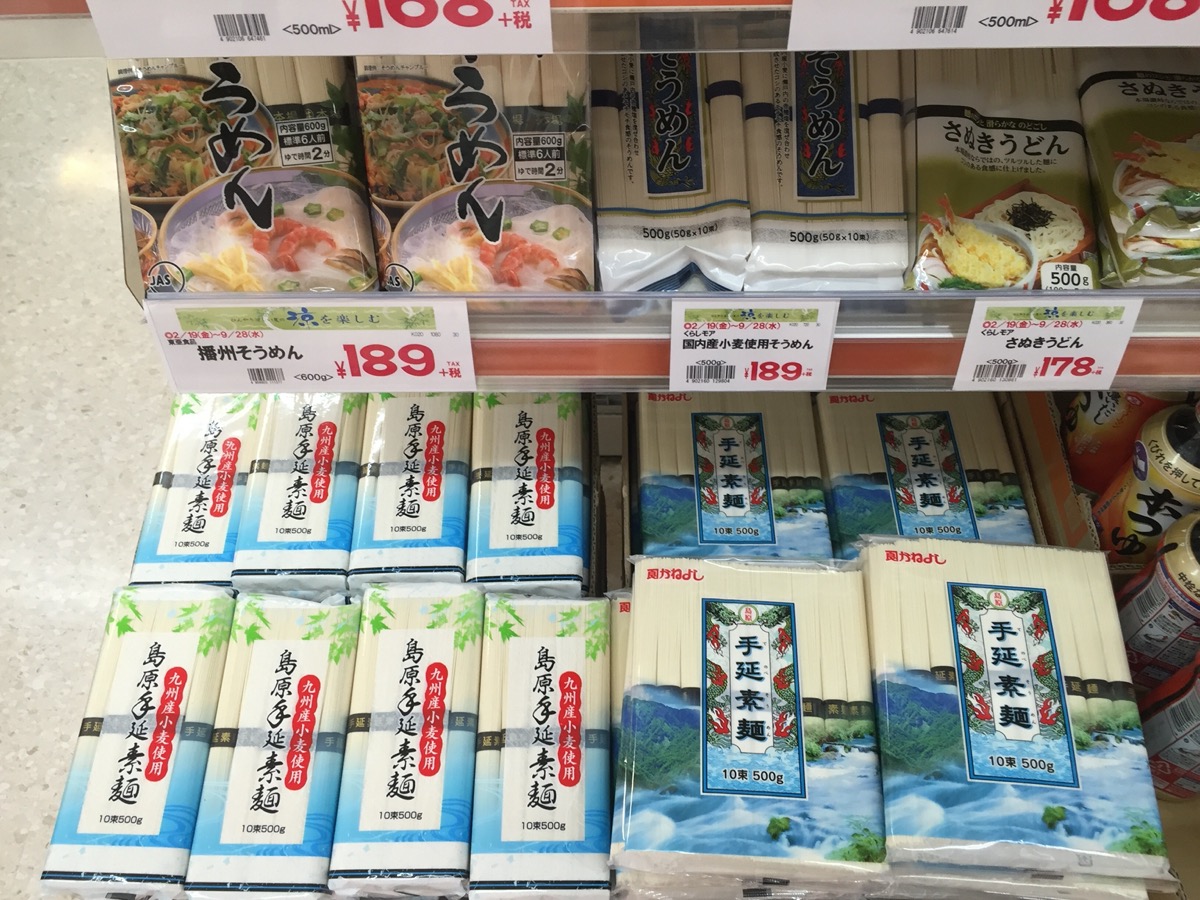
houzuki ほうずき, ホオズキ, or 鬼灯: Chinese lantern plant. It helps light the way for ancestors. These are really quite pretty, and really do look like tiny red lanterns.
senkou 線香 (ukou ウコウ in Okinawan): incense sticks (for purification). Often in Okinawa flat incense is used, called hiraukou ヒラウコウ (平線香).
bon-chouchin 盆提灯: lanterns; these are placed at the altar and the front of the house, so spirits don’t lose their way.
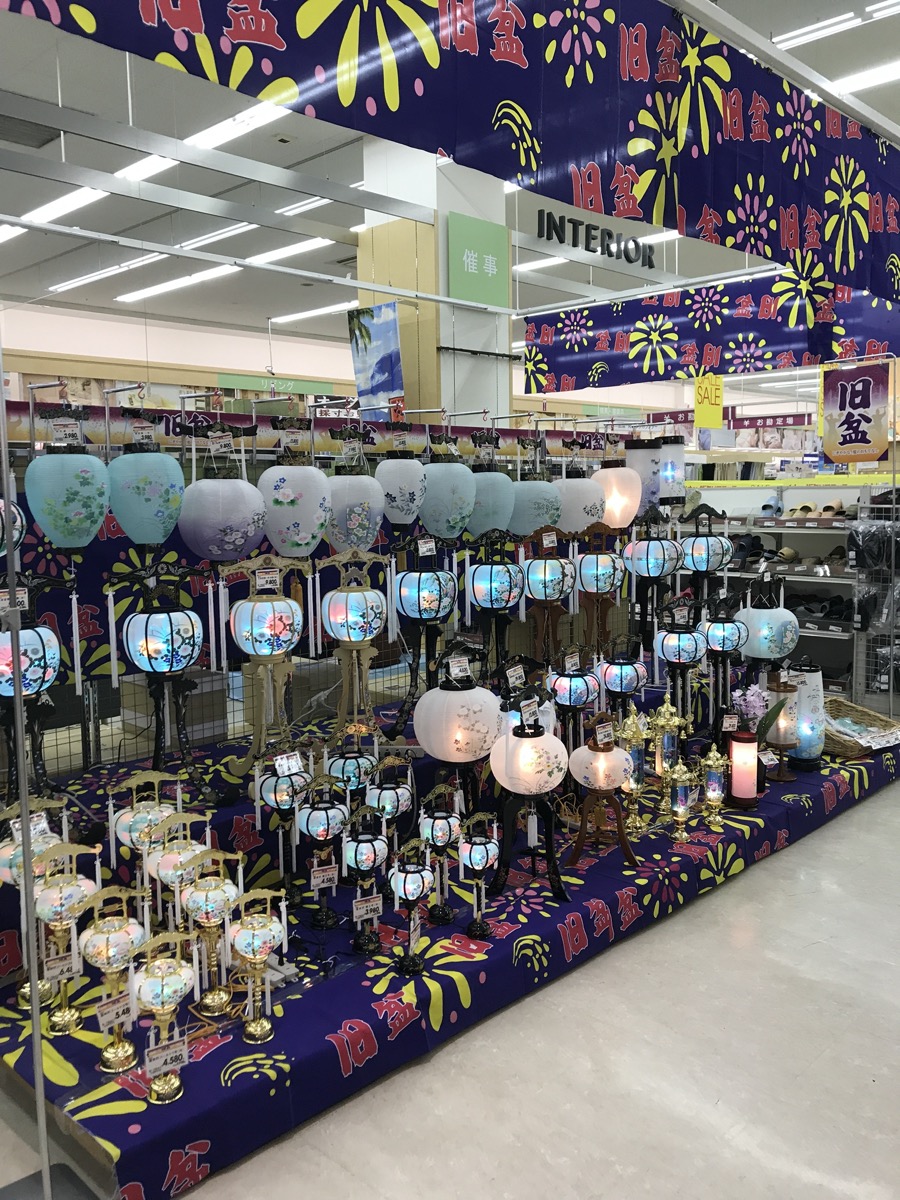
makomo まこも: mat woven from straw of wild rice, used in rituals.
Of course, flowers, seasonal fruits/vegetables, and your ancestors favorite foods (and drinks, usually beer or awamori) are also included on the altar. Typically UNRIPE fruit is used since it sits on the altar for 3 days… so sometimes it is not always so good to eat raw, but instead cooked. Also keep this in mind if you are fruit shopping at the markets during Obon, since many of these fruits will not ripen properly because they are picked so early! Look for signs that indicate 供え物 or 供え用 (translation: for offering/altar use); as well as signs like 青切り (translation: fruit picked early before becoming ripe) and 生食用ではありません (translation: do not eat raw). The 2 you must be MOST careful of are: sticks of sugarcane (it is not for eating and will not be tasty) and pineapple (can only be eaten cooked, do not eat raw). The bananas should be able to ripen somewhat but are also delicious cooked. Mikan (oranges) will be very sour, so maybe this is okay for some people. Unfortunately for many foreigners, the signs are always in Japanese explaining these things!
Below is a sweets offering set for the altar (お供え: offering, 菓子: sweets), easy to find in the grocery stores; unlike rakugan described above, these are in fact very tasty.
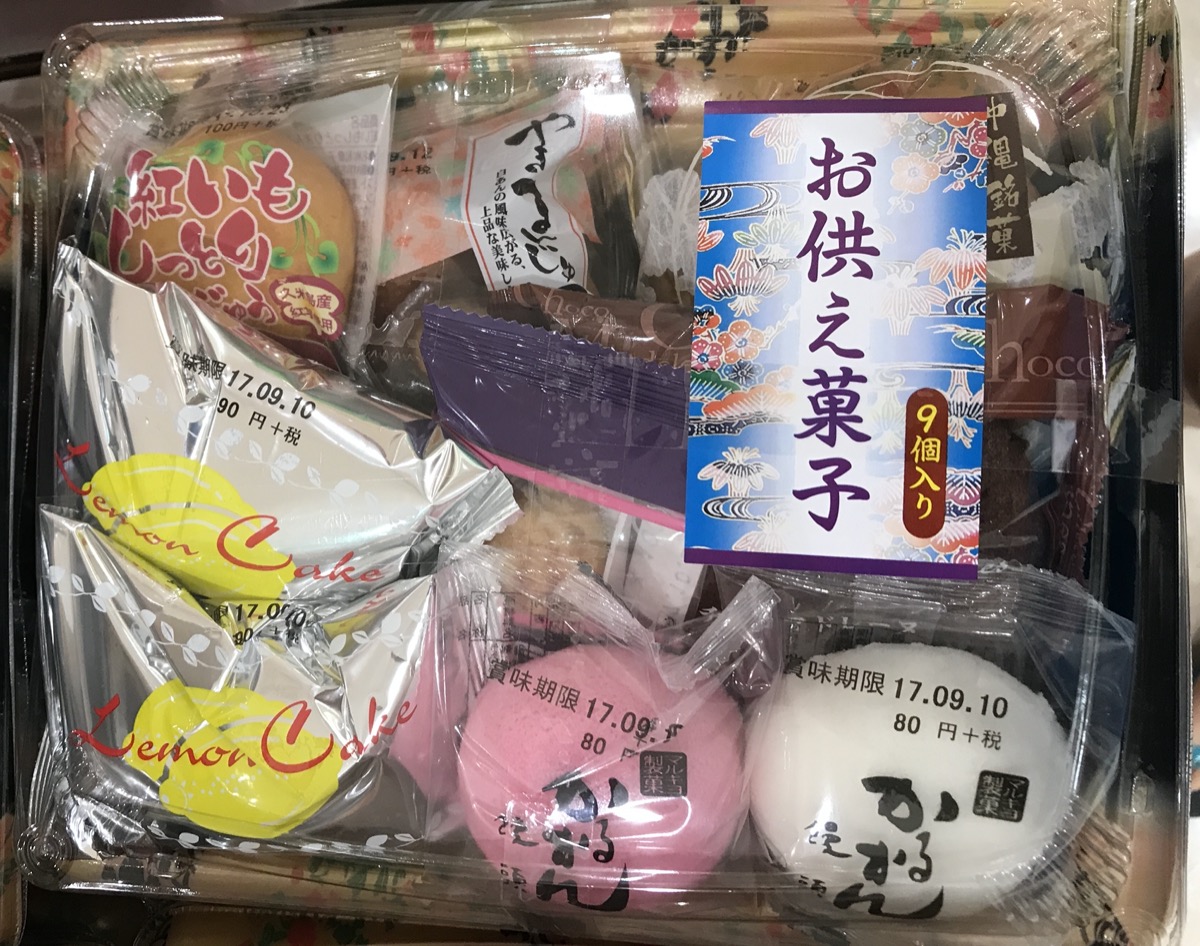
On unkeh, there is the custom of eating unkeh juushii ウンケージューシー, which is a type of Okinawa cooked rice with various things mixed into it. It is a simple, but popular dish.
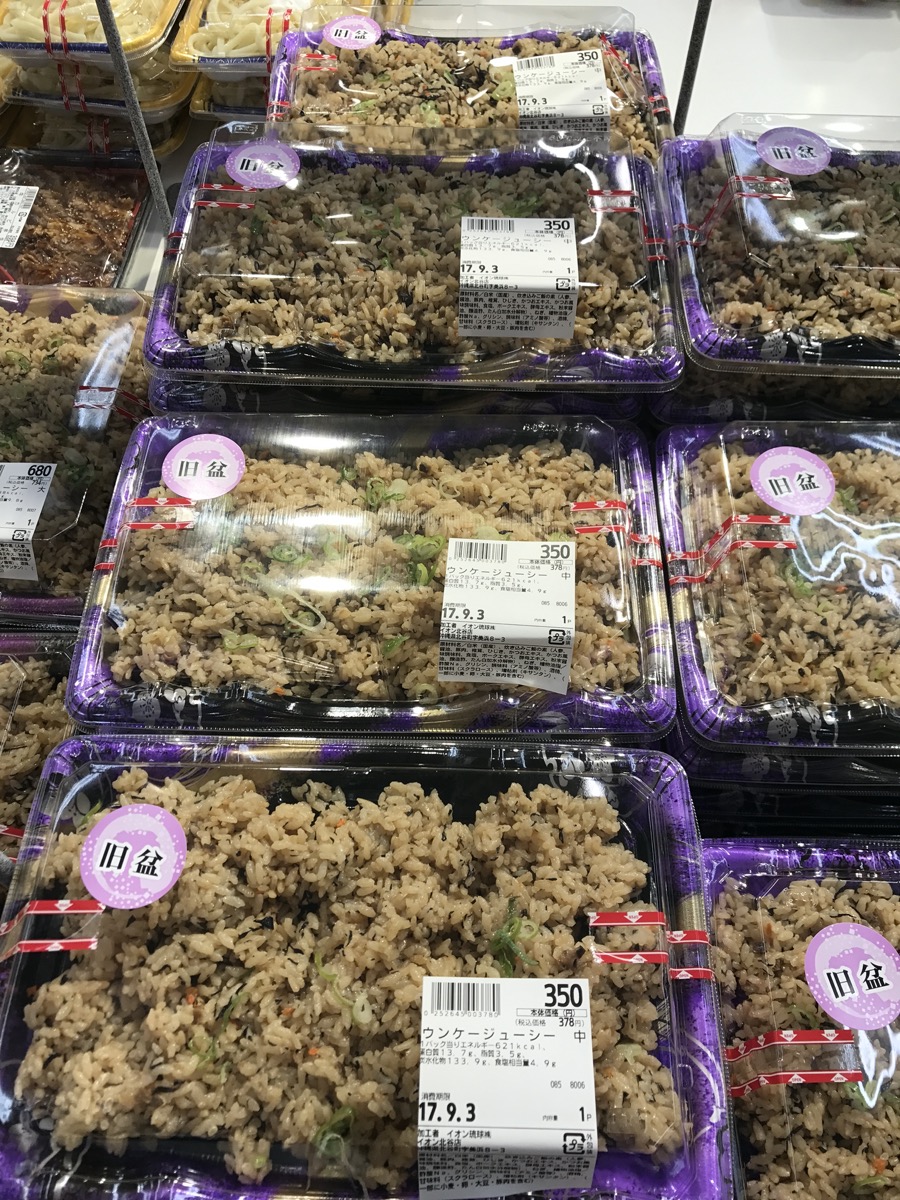
There is usually a box of specific foods during the feast day (ukui) called “usanmi” 御三味 (ウサンミ) that contains: fried tofu 揚げ豆腐, burdock root (gobou ごぼう), kelp (usually tied in knots), fish cake (kamaboko かまぼこ), konnyaku こんにゃく, tempura 天ぷら, fried taro (田芋 taimo) and of course, pork. There also usually a second box of white mochi (rice cakes) set out as well.
Not on the altar, but commonly served for during Obon are your typical trays of sushi, sashimi, fried things, chilled zenzai (sweetened red beans and mochi), cold somen noodles, nakami-jiru 中味汁 (intestines soup).
The local grocery stores in Okinawa have ads for all your Obon needs… this is an example of an advertisement from SanA. Anymore, many people just order trays of オードブル (pronounced ohh-do-bu-ru), which comes from the word hors d’oeuvres, instead of making it all themselves.
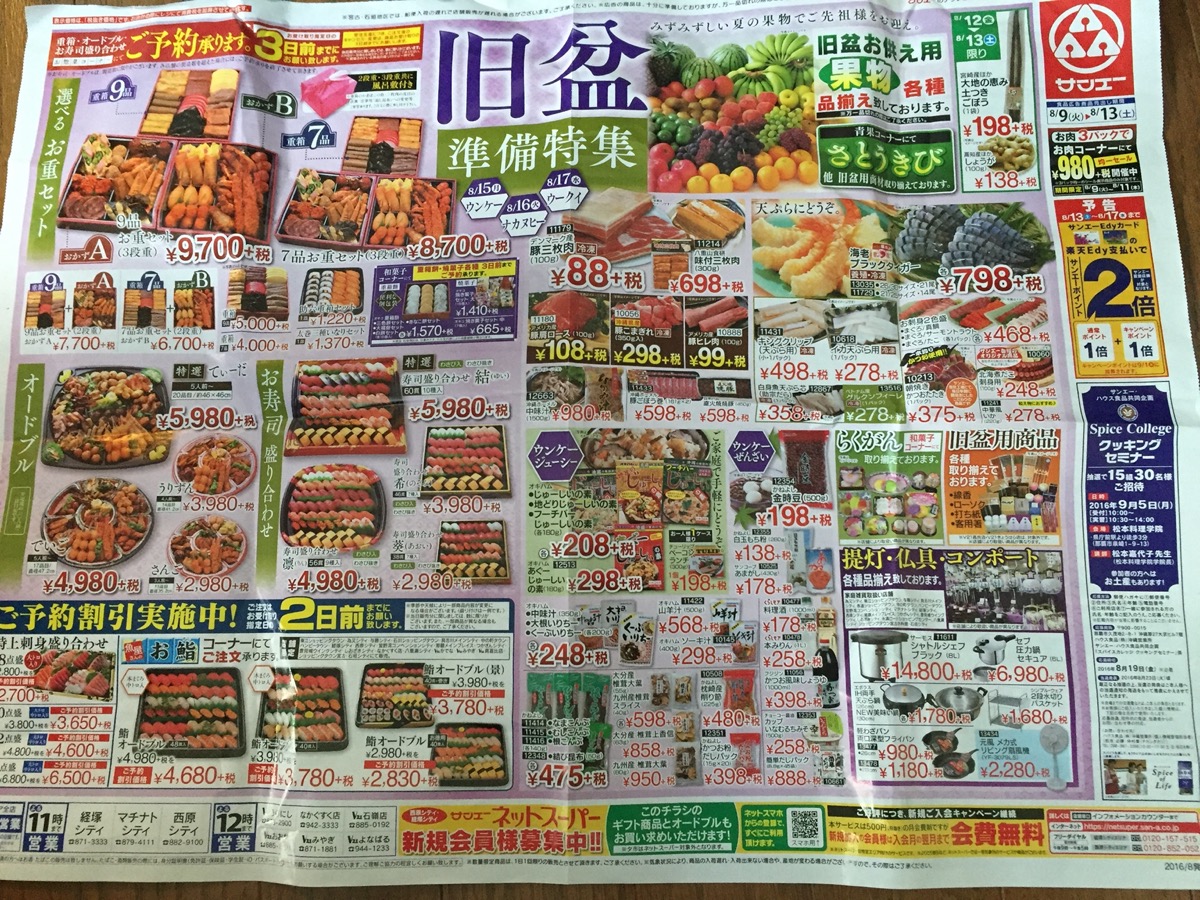
While most “events” are private in peoples homes, there are a few goings on, mostly in the form of eisa dance. Traveling groups of eisa often visit various spots throughout the community; by our house, one group comes to the FamilyMart and performs for a nice little show before moving on to the next location. If you live near Okinawa city and the middle part of the island, eisa typically goes on for all 3 nights of Obon, and sometimes another night after that, so be prepared for the continuous sounds of drums and sanshin (click here for Where to see eisa during Obon…). Another fun/interesting event is the Miruku-kami ミルク神 “parade” in Shuri.
I often walk through my neighborhood in the evenings; during obon time, all the doors and windows are left open to the houses. Drums and eisa dance chants ring through the air. I see neighbors burning or wrapping up offerings and leaving them outside on the walkways. It is somehow a nostalgic summer feeling.
In addition, people do not go into the sea during Obon, lest they be dragged to the underworld by deceased souls in the water (typically those who died by drowning or water accidents).
「イーヤーサーサー」 “i-ya-sa-sa-”
「ハーイーヤー」 “ha-i-ya-”
This is the sound of eisa. Anyone who has lived in Okinawa will recognize it immediately.
As summer approaches, so does matsuri season. Eisa is a synonymous with the summer matsuri season here in Okinawa. Eisa エイサー is a type of “bon dance,” 盆踊り (bon odori). Bon, or Obon, (written in kanji as 御盆 or お盆) is an important time of year for Japanese people; it is a time to honor and commemorate their ancestors. They believe that each year during Obon, the ancestor spirits return to our world to visit relatives. Bon occurs the 13th through the 15th day of the 7th month of the year; for many places this is July (according to the solar calendar), however in Okinawa, it is celebrated according to the lunar calendar, so it occurs sometime in August or September. I will leave the details of customs and traditions related to Okinawan Obon holiday for another blog post, and for now focus on eisa. During Obon in Okinawa, many eisa troupes will perform all around the island to bid farewell as their ancestors leave to Earth to return again to the heavens. There is a local group that travels down our neighborhood and town, stopping at various points to perform; we are sure to watch them as they dance, chant, whistle, and play drums in front of the convenience store across the street.
Due to the large Japanese population in Hawai’i, Obon is also commonly celebrated all over Hawai’i throughout the summer months– so this holiday and bon dance in general is not really new to me, but I have learned about some of the more Okinawan traditions and especially eisa dance.
Although eisa originates as a bon dance, it is performed throughout the year and is considered an important aspect of Okinawan/Ryukuan culture. There are several eisa clubs around the island, and they are especially busy during the summer matsuri season. Already at my university they are practicing for summer during lunch and early afternoon, so I have some entertainment these days while I eat.
There are guys (and sometimes girls) playing larger (taiko) drums, as well as those with smaller hand drums. Usually the females are dressed in simple yukata with Ryukyuan designs. At least one of the guys will be dresses as “Chondara” (Okinawan clowns).
The role of the chondara is to cheer the dancers on and entertaining the audience, as well as guiding the group in the right direction. Sometimes also to scare the small children a bit.
The sounds of eisa wafting through the evening air, while sitting outside and drinking a beer sometimes feels a bit nostalgic as strange as that seems. It has that feeling, that summer has indeed arrived, and will soon be gone so be sure to enjoy the (hot and humid) weather now and the carefree feeling of lazy summer days, because soon it will be replaced by chilly fall and winter winds.
Preview some terribly taken videos of eisa:
https://youtu.be/JAM9VCQs2so
In Okinawa, as summer approaches, the mornings are getting much warmer and the desire for an iced cafe latte grows stronger. Starbucks is too expensive, so where is the best deal for an iced coffee drink? Lawson conbini!
コンビニ conbini (or konbini) means convenience store. Lawson is a major chain of conbini throughout Japan. Conbini in Japan are amazing, and nothing like what you see stateside! But I will not get into all those details now. Right now, I will focus on Lawson’s machi cafe line.
Inside every Lawson, you can order several types of coffee drinks from the counter. My favorite during summer, of course, is an iced cafe latte アイスカフェラテ. I have tried iced cafe lattes all around the island, but I have found that the best priced (and consistently good tasting) one is at Lawson conbini, for a mere 150円. Comparing this to Starbucks which is usually more than 300円, I would say this is much more reasonable. FamilyMart, another large country-wide conbini chain, has iced cafe lattes for 180円, a little bit more than Lawson (but, also pretty darn good). In Okinawa, there is the occasional Tully’s (but they are not very common) and a scant few other chains with only one location about (Saint Marc ChocoCro, Doutor, Key Coffee), but they are so few and far between that I am rarely anywhere near them. There is the Climax Coffee chain, located on the other side of the island from me, similar to a Starbucks (similar price, too). There are several small independent shops which also have cafe lattes, but they tend to be fairly expensive, so while very good quality… simply not an everyday drink.
So when it comes down to affordability, taste and convenience for an iced cafe latte, Lawson wins.
Plus for you those of you who desire less caffeine… they just released a 97% caffeine cut series (basically, decaf) as of May 2017! This is great news for my husband, who can now enjoy an iced latte in the afternoon without worrying about caffeine.
Japanese coffee vocabulary: the best part is that it is almost always katakana!
コーヒー ko-hi coffee 珈琲 ko-hi- coffee (the kanji is based on the sounds not the meaning) ブレンド burendo blend アイス aisu iced フローズン furo-zun frozen ホット hotto hot カフェラテ kafe rate cafe latte カフェモカ kafe moka cafe mocha 抹茶ラテ maccha rate matcha (green tea) latte ロイヤルミルクティー roiyaru miruku ti- royal milk tea ココア kokoa cocoa アールグレイティー a-rugurei ti- Earl Grey tea 砂糖 satou sugar 砂糖なし** satou nashi: without sugar クリーム kuri-mu cream シロップ shiroppu sugar in syrup (liquid) form **なし nashi means "without"-- a very useful word!!
Okay, now this part may seem a little silly, but how do you order a machi cafe at Lawson if you don’t really know any Japanese? Let me help; just keep in mind there are often variations in speech patterns, so depending on your clerk, they may use different phrasing, as well as formal or casual speech.
First, before you approach the register, decide what you want from the menu (okay, maybe that is obvious). I get a latte, so let’s practice using that as an example.
ホットカフェラテ、おねがい(します)。hotto kafe rate, onegai (shimasu).
Hot cafe latte, please.
If I want it iced, I used アイス “aisu” instead of ホット “hotto.” Yes, seriously, we use Japanese English in this case.
The clerk will than ask what size if what you are ordering comes in 2 sizes. Sometimes I say the size when I order, but often times they will ask it again to confirm anyway. The shortest and most casual way they say this is as follows. Sometimes they will say it formally, but just listen for keywords.
サイズは? saizu wa? What size?
In which you reply:
Lサイズです。 eru saizu desu. L size.
or
Mサイズです。 emu saizu desu. M size.
At this point, they are probably ringing up your total. At some locations, the coffee pickup counter is to the side, so they will say something like:
となりのカウンターお待ちください tonari no kauntaa omachi kudasai. Please wait at the next counter.
Keep in mind there are many variations on this. The key word here is “machi” 待ち or “matte” 待って, meaning “waiting” or “to wait.” The other keyword is “kauntaa” which is “counter.”
Some places will ask how many sugars you will want either while they are ringing you up or while you are waiting for the machine to make you coffee. Listen for:
砂糖はいくつ(入れますか)? satou ha ikutsu (iremasuka)? How many sugars (do you put in)?
Keyword here is “satou” which is “sugar.”
Your response:
なしで。 nashi de. None.
一個。 ikko. One.
二個。niko. Two.
三個。sanko. Three.
Sometimes they do not ask about sugar and it is self-serve. In this case this will point to the little bin with sugars and stirrers and the like as they hand you your coffee (it will be obvious). They will instead say something like:
砂糖、どうぞ。 satou, douzo. Please help yourself to sugar.
When they hand you your coffee they often (but not always) say:
お待たせいたしました。omataseitashimashita. Thank you for waiting.
At this point when you receive your coffee you can respond with a casual “doumo,” or if you feel like “arigatou” or “doumo arigatou,” etc.
Again, keep in mind there are so many variations, and in order to not confuse you, I just put down some basics and keywords to listen for so your transaction can go smoothly! These are the “bite-sized” phrases to simply get you through the process. I like to remind people that in Okinawa, speaking informally is a bit more the norm; besides this, many people appreciate your effort in speaking even just a little Japanese as a foreigner, so worrying about formal/casual language is not nearly so important as many people make it out to be.
担々麺 (tantanmen) or 坦々ラーメン (tantan ramen) is a popular “Chinese-style” noodle dish in Japan. It is typically seen as ramen (but occasionally as tsukemen, aka dipping noodles). It is often found at ramen and Chinese restaurants. A few shops in Okinawa will advertise it as a specialty dish of the shop. I know of quite a few shops with tantanmen not far from my area. I frequently see banners outside of ramen shops advertising tantanmen.
Tantanmen usually has a spicy broth with thick sesame taste, topped with minced pork and green onions. It is supposedly Sichuan-style, although Japan often tones down the spicy levels and focuses more on the rich, sesame qualities of the broth.
Some of the better places in Okinawa to try tantanmen (I will try to add some more restaurants):
坦々亭 Tantantei, Ginowan: https://goo.gl/maps/krvCHNVhthE2
ラーメン工場無双 Ramen Factory Musou, Ginowan: https://goo.gl/maps/ab42CAQ7peR2
あけぼのラーメン Akebono Ramen, Naha: https://goo.gl/maps/8u1aZTAQHTw
燕郷房 YanKyouFan, Naha: https://goo.gl/maps/548MMuMrwAu
*Arashi ramen 嵐, Stripe ramen, and Tenkaipin ramen 天下一品 are very popular with Americans, most likely due to the fact they have English menus and are close to American bases. I do not tend to patronize these places, but many other people seem to enjoy them, so decide for yourself if you want to check them out. My husband says the fried rice at Arashi is pretty good. Both Arashi and Tenkaipin are large restaurant chains from the mainland. I am not sure on the menus, but I am fairly certain they have tantanmen, or some variation.
だるま (達磨) Daruma are round, and usually red, Japanese traditional dolls with a bearded man’s face painted on it. The eyes are left blank; it is used to keep track of aspirations or goals and motivate you to work hard to accomplish them. The recipient of the doll fills in one eye upon setting the goal, and then the other when it is completed, such that every time you see the one-eyed daruma you think about reaching the goal. Daruma are symbols of perseverance and good luck, which makes them a popular gift of encouragement. Darumas are usually made of papier-mâché and are hollow with weight at the bottom so that they always return to an upright position when tilted over. This characteristic has come to symbolize the ability to have success, overcome adversity, and recover from misfortune.
There is a temple dedicated to daruma near Shuri-jo. It is called Daruma-dera Sairaiin だるま寺西来院. Students come here to offer prayers when exams are near, and I think this one is also popular for families to come pray for safe and easy childbirth. It is a small temple, but full of character. This lovely temple is located behind the Shuri-jo area, and well worth a visit when you are in the area.
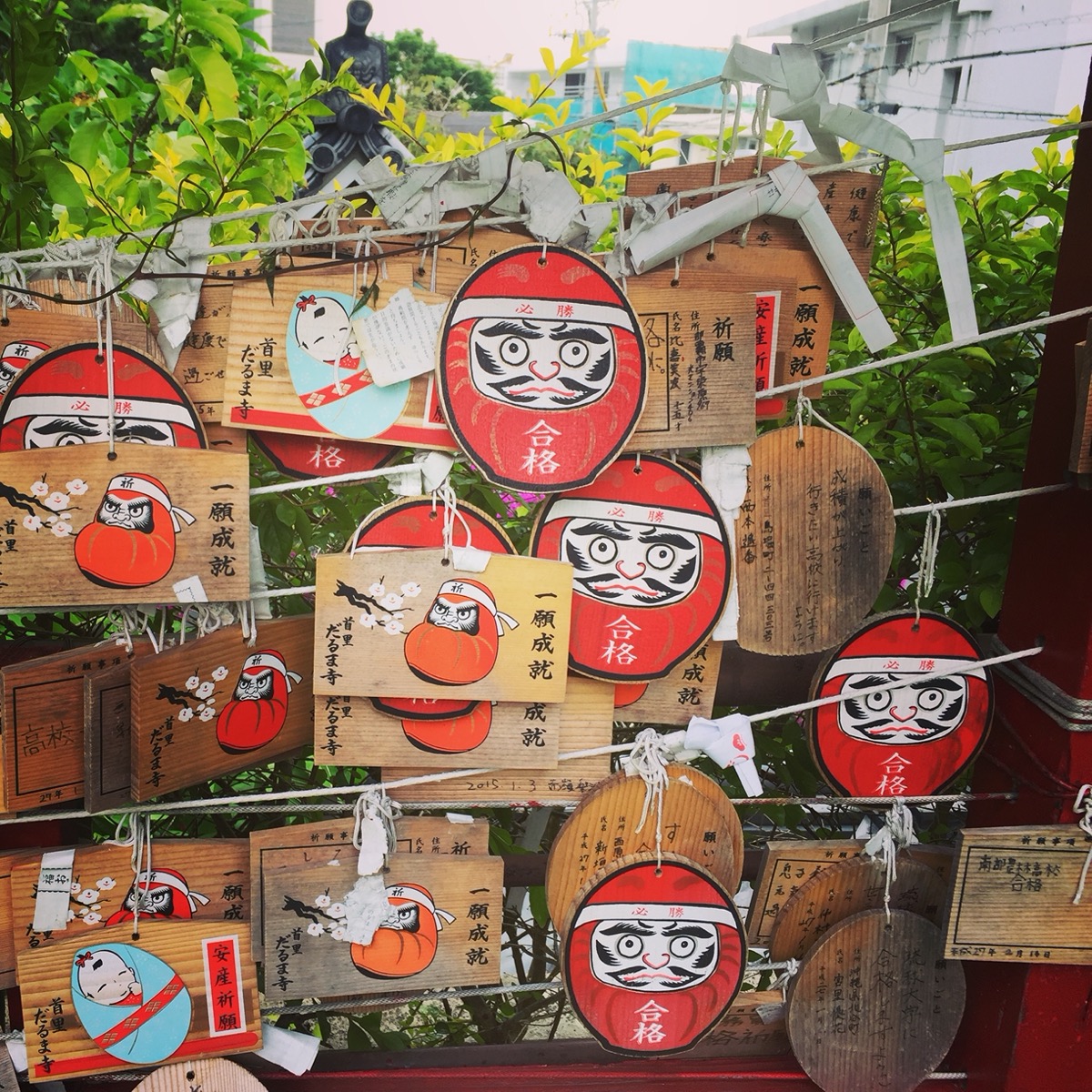
モーウィ, or in kanji 赤毛瓜
This can be romanized a few ways: moui or mo-i, I think are most common. Moui known in English as Chinese cucumber, red gourd, or just yellow cucumber. It looks just like a giant yellow-orange cucumber. It is a pretty common summer vegetable here in Okinawa, and since it is getting cheap in the markets, I will probably make some pickles from it.
It pretty much tastes and looks like a large yellow cucumber. It can be eaten plain, pickled, added to salads, or even cooked in soups. There are some Okinawan recipes for using it in side dishes.
Click for a pickles recipe using moui on this page. Perhaps later I will add in some other recipes from local friends.
Tsuken-jima, aka “Carrot Island,” is a short and cheap ferry ride (~15-30 minutes) from the Okinawan main island. I can see this island from the window of the second story of my house.
The word carrot in Japanese is ninjin 人参 but oddly enough you may see it as キャロット “kyarotto” in katakana.
It is an easy day trip and the whole island can be seen on foot. There is no need to bring a car or rent a car. There is a trail, mostly paved, that runs along the island. There are several utaki (Okinawan sacred forest/spots), a few hiijaagaa (water springs, usually somewhat sacred), and an observatory shaped like a rusty orange carrot with panoramic views. Basically, it is a nice walk. The water is beautiful, so water activities are also a possibility here.
Of course, there are many carrot fields and bags of carrots are sold here, as well as various carrot products, like cakes and breads. There is even a “carrot cider” (however the word cider サイダー in Japanese actually refers to soda, just as an fyi).
On this particular trip, I slipped and ended up breaking my camera, so the only photos are from the beginning of the hike… but I promise, it is quite nice the rest of the way, too.
お好み焼き Okonomiyaki is considered Japanese junk food… but it is delicious! It comes from the phrase “as you like it”; basically it is a simple recipe with cabbage and a pancake-like batter that you add toppings as you desire. There are 2 main styles: Kansai (or Osaka) style and Hiroshima style. I tend to prefer Kansai style, even if it is a bit more simple. In Okinawa, there is something not quite the same, but many people refer to as Okinawan okonomiyaki, called hirayachi.
Kansai style (関西) is a mixed batter, then cooked in a fry pan or on a flat grill top. If adding bacon, it is just added in strips to top side before you flip and cook the top side. When its cooked, it is served with nori (seaweed sprinkles) のり, katsuobushi (shaved bonito flakes) 鰹節, a thick sweet brown sauce (called okonomi sauce) お好みソース, and mayonnaise. Often there is benishouga (pickled ginger) 紅生姜 on the side.
Hiroshima (広島) style is layered instead of mixed, making it a bit more complicated to cook. Usually it includes a fried egg and yakisoba noodles inside as well. It is served in a similar way to Kansai style, with the okonomi sauce, nori, ginger, and mayo.
I enjoy eating at okonomiyaki restaurants, especially the ones where you can grill it at your table. In Okinawa, there are not many okonomiyaki restaurants, but there is a really good one called Heshin 海神 located in Awase that is not too far from me and serves Kansai style. Red Helmet 赤いヘルメット is a Hiroshima style place in Okinawa city. They are really good, for Hiroshima style. I think I may prefer Kansai style for its simplicity, though. But I think everyone should try them and decide for themselves which style they prefer. Heshin and Red Helmet are definitely the top 2 okonomiyaki places in Okinawa. There are some other places you can find it in Okinawa, these 2 places just happen to be some of the best. You can nearly always find okonomiyaki at summer festivals (natsu matsuri 夏祭り), too, as it is a very popular summer festival food.
Simple okonomiyaki is fairly easy to make at home though; all the ingredients are widely available. You can even buy kits that have all but the fresh ingredients inside (just buy your own cabbage, egg, bacon, green onion).
What do I like in my okonomiyaki? Well, definitely benishouga (pickled red ginger) on the side. I go for vegetable-based and skip the bacon. I usually order extra green onion. If I feel a bit different, I might add kimchi, cheese, and/or mochi bits. For those of you that like seafood, there are usually various things like shrimp (海老), scallops (ホタテ), octopus (たこ), or squid (いか) to mix in the batter. Many places will usually offer different types of meats for the batter as well.
When you visit Japan, eating okonomiyaki is a must-do!
address for Heshin 海神: 沖縄県沖縄市与儀715 マンション伊波 1F
https://goo.gl/maps/kxS1eeLp5nR2
address for Red Helmet 赤いヘルメット: 1 Chome-14-16 Hiyagon, Okinawa, Okinawa Prefecture 904-2173
https://goo.gl/maps/6AXYDmCeU372
**neither of these places have English menus… just be prepared for when you visit!
Here is a list of some other decent Okonomiyaki restaurants in Okinawa. Again, most of these do not have English menus; I think Sanshiro in Ginowan is the only one with an English menu. Other than that, there was an okonomiyaki shop in American Village with an English menu but they were not very good in my opinion (so I have not listed it here).
Maido まいど: https://goo.gl/maps/dXQ57V5DXSw
KO菜YA (Shintoshin location): https://goo.gl/maps/KgPaTCjxpRs
Sanshiro 三四郎: https://goo.gl/maps/psodkY3E6TL2
Umanosuke 馬之助 (Ginowan location): https://goo.gl/maps/LcAp67rvLwK2
石垣島 Ishigaki-jima is one of the southern islands in the Ryukyu chain, known as one of the Yaeyama islands 八重山諸島. To get there, you need to fly from Naha, Okinawa main island into Ishigaki airport. The fare is somewhat reasonable, typically ~15000円 roundtrip. Once you get there, it is probably best to rent a car, or at least a moped. You can also rent bicycles many places.
As far as sights go, there are a few must-see stops. Kabira Bay is probably on the top of the list, with stunning natural beauty. There are some other things “to see,” but Ishigaki is more about natural beauty than man-made sights. I recommend snorkeling or diving, kayaking, hiking, star-gazing… or just enjoying the outdoors! Perhaps check out Banna Park or the limestone cave, maybe one of the observatory viewpoints.
According to my sensei, whose cousins grew up here and thereby he visited often, eating beef soup on Ishigaki is highly recommended. Many people also recommend some of the more expensive Ishigaki yakiniku (BBQ) if you are in the mood for something a little fancier, but usually these place do not open until dinner time. Another cheap option would be Yaeyama soba, which is slightly different from Okinawa main island soba.
For me, Toufu no Higa is a must. I know it is not exactly on the “tourist path,” but as a foreigner, I found it unique and fantastic. It is a meal for the average working man (and woman).
Obviously there is locally produced awamori should you want to try it, but there is also a craft beer brewed in Ishigaki, which is definitely worth a try while you are there.
**Bonus trips from Ishigaki, via ferry (I will make separate posts for these later):
-Taketomi-jima: Recommended. See the old traditional houses with their colorful reddish roof tiles, explore the small streets, take an ox-cart ride, visit the squirrel monkeys.
-Iriomote-jima: Popular visit among tourists. Ox-carts, squirrel monkeys, and the Iriomote wildcat.
-Hateruma-jima: the southernmost island in Okinawa prefecture! This is on my list of places to go, and I hear the night sky is breathtaking here.
スタンプラリー Stamp rally. This is probably what it sounds like…
As a visitor, you may notice in some places (especially tourist sites) there are large stamps and ink pads. They sometimes have intricate designs, representative of the town or historic site. Sometimes they are just cartoon characters. But whichever they are, they usually serve a purpose: as a step in a “stamp rally.”
What does a stamp rally mean exactly? Well, typically this is geared towards children. You pick up an official paper grid with blank spaces at a central location, such as the information desk or a ticket office. Then you go around the site and look for the stamp stations, each with different designs. The goal is to find all of them and stamp each piece of your grid with every design. Once you finish, there is sometimes a small “prize.” It is basically a game to keep children entertained while touring places.
These are some examples (I will upload more later):
While I do not normally participate in these, sometimes I still enjoy adding a stamp to one of my travel books as a reminder of my visit. It’s kinda cute. It has even started to get high-tech as some big tourist sites will have an app and you scan QR codes at various locations to “collect stamps.”
All this aside, I have another theory as to why stamp rallies exist, but first some background. Personal stamps/seals, called “hanko” 判子 or “inkan” 印鑑, are important in daily life as an adult… it is necessary for bank accounts, receiving packages, school registration, legal transactions… etc! Even as a foreigner, I have a small hanko that I use for just these purposes. Honestly, these seals really are surprisingly used every day; my graduation certificate and school ID have imprints of the university and president’s seal, many documents need to have my advisor’s or sensei’s seal on them, during the university physical exam I need to “pass” each section to get each individual doctor or nurse’s seals, I even personally have to use my seal to log in my research assistance hours. I have taken to using my seal instead of my signature for whenever the delivery driver drops off packages ordered from the internet. Basically, it is like a personal signature. So… my point is, I believe that stamp rallies are just practice for small children to gather or collect stamps as they will need to in adulthood! Seriously, it is like preparation for life. Get your papers stamped because in order to get through life in Japan, you need people to stamp your papers so you can move forward or gain accomplishments (as an adult, these are our “prizes”).
Next time I get my university physical exam, I will take a photo of my own personal stamp rally I must complete in order to prove my health. It is literally a stamp card that I take to various stations where certain aspects of my health are evaluated. Each section of the card gets filled out with details and each doctor/nurse stamps the section to prove that I “passed.” The first time I had to do this, all I could think about were the children I saw at Shuri-jo racing around and filling out their stamp rally so they could get their sticker prize at the end.
にんにく Ninniku means garlic in Japanese; in Okinawan it is ヒル hiru. Some of my neighbors grow lots of fresh island garlic for cheap, so I am particularly lucky. In Japan, Aomori (towards the north) is a large garlic-producing region, but the garlic is rather expensive. Many stores sell garlic imported from China for cheap. So when Okinawa garlic season is in full swing, I take advantage and buy a lot, because it is fresh, tasty, and cheap. It is not as dried out as other garlic, so it tends to have a fresher scent, and perhaps a bit sharper taste.
Recently, I have made some batches of ninniku-shuu にんにく酒~~ oishii! In Okinawan, it is known as hiru-zaki ヒルザキ, although some people may even refer to it as にんにく泡盛 ninniku awamori. I have heard some people drink this (?!!) as sort of a medicinal thing, but I cannot help but imagine that is simply too strong. It is also used as a condiment for cooking, and especially goes really good in stir-fry dishes. Basically the garlic soaks in the awamori (or other strong clear liquor of one’s choice) while the garlicky essence permeates the liquid… sort of like making an extract I guess. Anyhow, it is actually really good, and with all this local garlic, it is a good way to capture the flavor when fresh garlic becomes scarce in the later months.
On the mainland, I think most people use something referred to as “white liquor” ホワイトリカー or shochu 焼酎 to make ninniku-shu. In Okinawa, of course the local favorite would be awamori. So… awamori it is for me, as well.
Hirayachi is considered Okinawan okonomiyaki, but I think it resembles Korean chijimi (チヂミ in Japanese). The word hirayachi means to “fry flat.” This is a popular snack food and izakaya food, I think because it is simple yet delicious, as well as easy to eat.
It is a pancake type of batter with only a few ingredients: flour, egg, water, salt/pepper, and green onion mixed together, plus a little oil to fry in the pan with. To serve, most people top with shaved katsuobushi (or bonito flakes) and with either Worcestershire, yakisoba sauce, or okonomiyaki sauce (whatever you prefer). I confess that I will typically use Bulldog brand tonkatsu sauce to serve, and add some pickled ginger on the side.
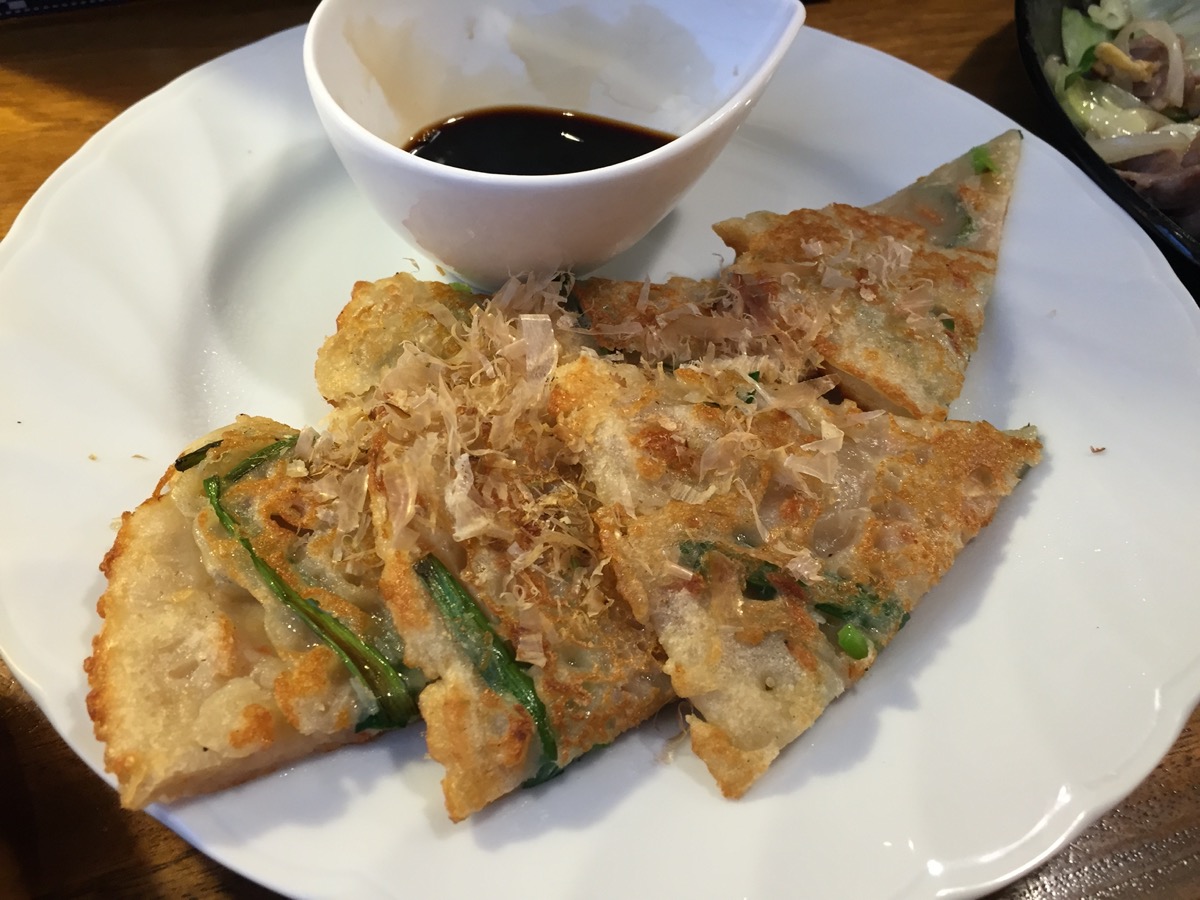
ハーリー haarii, or in Itoman called ハーレー haaree, are dragon boat races. In Okinawa on May 4th of the lunar calendar, just as the rainy season comes to a close, the season of haari begins! There are races enarly every weekend through July.
It is a festival for fishermen to pray for a large catch and safe sailing. In Okinawan language, fishermen are called “uminchu” うみんちゅ (海人). The festival comes from China a few hundred years ago. There are several locations within Okinawa that Haari is held; the most famous are in Itoman and Naha. The is also a festival and race in Oujima (some people spell it Ojima) 奥武島, the island of tempura!
In Shuri, near the castle, I teach 英会話 eikawa; “English Conversation.” My class is predominantly “older” Okinawan/Japanese women (although the 1 man is actually a rather well known figure within Okinawa, and has recently won a special award from the Emperor). After class, sometimes I will take lunch with them, and we usually go to this cute restaurant located within a women’s mental health clinic. 喫茶 kissa means like coffee/tea cafe, so I usually just call this place Cafe Ufu.
Cafe Ufu is on the small side, only a few tables, and a tatami room for larger parties. The menu is pretty simple; usually people just order the set of the day, which comes with a variety of carefully prepared, healthful Japanese dishes. Everything there always tastes so good, and I usually feel pretty genki afterwards. Plus is is so reasonably priced ~800yen!
Even though it is next to a women’s mental health clinic, it is not just for women, so men should visit, too. Although the meals might be more geared towards ladies in mind!
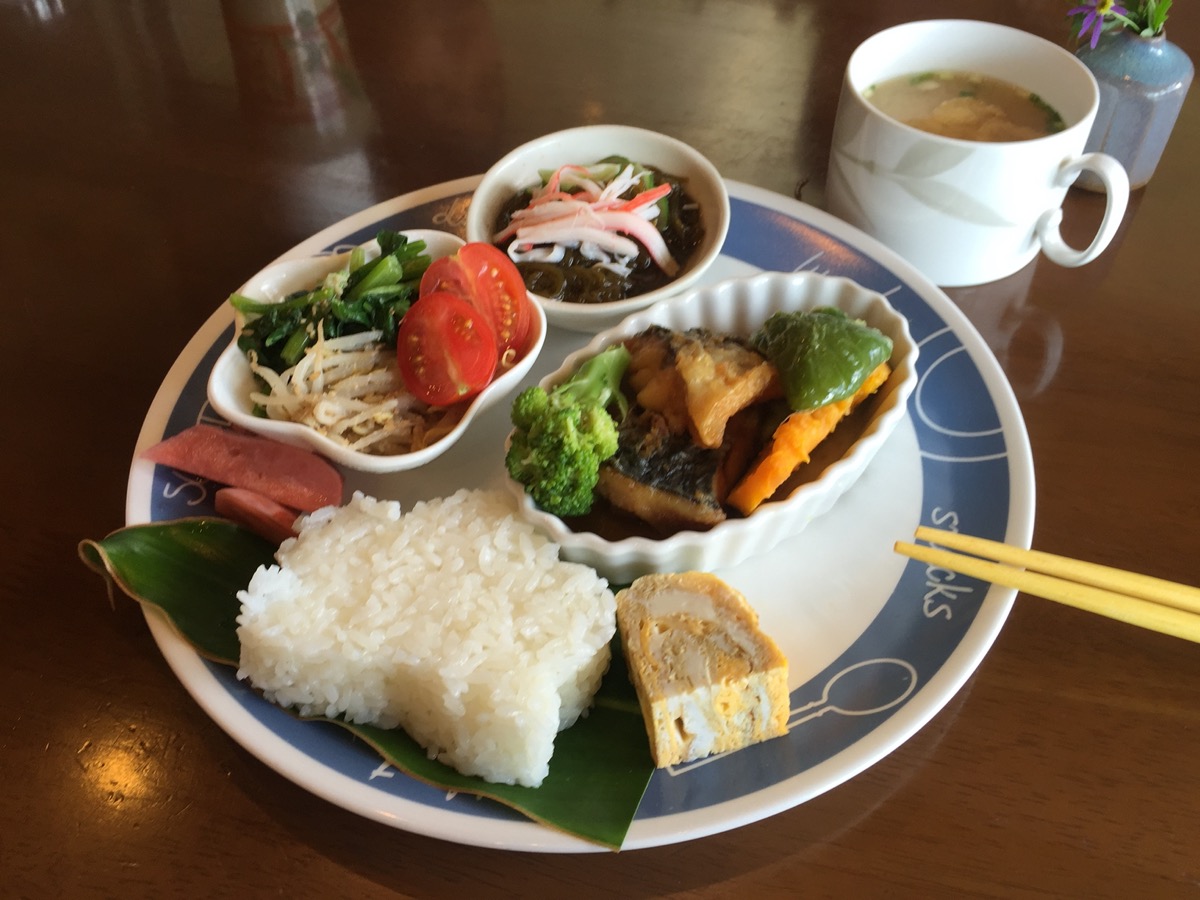
address: 沖縄県島尻郡南風原町新川507-1
(ウィメンズメンタルクリニックみなみ)
There are a fair number of temples (tera 寺) and shrines (jinja 神社) in Okinawa, however, most of them are maybe not as historic or grand as you might see on the mainland.
成田山福泉寺 Naritasan Fukusenji is the temple in my town. It sits upon the hill facing the ocean. I visit there during important yearly events, such as New Years and Setsubun.
Omamori お守り are amulets or protective charms you can purchase from the temple. They come in many forms, colors, types; some are for safe driving, some for success in school, some are for health, some for love… There are some traditions around these, which some people do not necessarily observe. After a year (usually, but I will not lie, I often keep mine longer than that), you should take back to a temple to have them perform a ritual and burn it, and then obviously purchase a new one. I usually only keep my New Years omamori for a year and then return them during the next New Year; others, especially ones from places I have visited, such as Kyoto, I tend to keep until they look a bit worn.
Wood prayer boards, called ema 絵馬, are often sold as well (more common at shrines, but temples nowadays often sell these as well). You write messages of prayer, such as wishes for happiness, health, success in school, love/marriage, safety, etc, and hang them up by the shrine (so the gods, or “kami” 神, can receive them). The ema have pictures representing the temple, or perhaps the zodiac year, on the back; usually there are a few designs you can choose from. There are no real rules as to what or how to write on an ema, so just have fun.
How to pray at a Shinto Shrine (temples are less rigid, although some of the procedure can be the same):
- purify oneself at the water pavilion: using your right hand, take a ladle, and scoop water. Pour a little over you left hand, then switch an pour over your right hand, then in your left hand take some water from the ladle and rinse your mouth, and finally empty the remaining water (on the ground, not back into the water basin). You should only scoop water once. When you finish, use your hand towel to dry you hands. You will notice many people in Japan carry around small personal towels in their bags, and if you visit, I highly recommend also having one for instances such as these.
- toss a coin gently into the offering box (preferably with hole in it, 5円 or 50 円)
- ring the bell (if there is one)
- bow twice
- clap twice
- pray (silently)
- bow once
And done! Pretty easy. All being said, sometimes procedure can switch up depending on where you are, so just follow what locals do when you feel uncertain.
Lastly, let’s cover drawing fortunes, known as omikuji おみくじ. There will be a box or a coin slot machine labeled おみくじ. Some places will have English fortunes, some only Japanese. It is usually 100円, although it can be more if it comes with a small charm of some sort (if it is a small frog charm, put it in your wallet, it is said to “attract” money). Fortunes will have a category, ranging in different types of luck, from very good to very bad:
Great blessing (dai-kichi, 大吉)
Middle blessing (chuu-kichi, 中吉)
Small blessing (shou-kichi, 小吉)
Blessing (kichi, 吉)
Half-blessing (han-kichi, 半吉)
Ending blessing (sue-kichi, 末吉)
Ending small blessing (sue-shou-kichi, 末小吉)
Curse (kyou, 凶)
Small curse (shou-kyou, 小凶)
Half-curse (han-kyou, 半凶)
Ending curse (sue-kyou, 末凶)
Great curse (dai-kyou, 大凶)
On the rest of the paper, it describes your luck or fortune in various aspects of your life. Most of the Japanese used is fairly complicated, so it is good if you can have someone fluent explain it to you. Once you read your fortune, if it is bad, you tie it to a tree branch at the shrine or temple, to stave off the curse; if it is good, you keep it close to you (in your wallet or purse perhaps). That being said, I have also heard if it is good you tie it to a tree branch in order for it to come true! So, I think sometimes, there are no “right” or “wrong” ways. Just have fun.
While there are many small shrines scattered around, here are the addresses for the “larger” temples and shrines worth visiting in Okinawa:
South:
Naminoue Shrine: Naminoue Shrine: 波上宮
Daruma Temple in Shuri: Daruma: だるま
Sueyoshi Shrine in Shuri: Sueyoshi Park & Shrine: 末吉公園&宮跡
Okinawa Gokoku Shrine: https://goo.gl/maps/FhAbZoJmxFU2
Gokukuji (temple): https://goo.gl/maps/adYNcwXmRHu
Central:
Narita-san Fukusenji: 〒901-2403 沖縄県中城村伊舎堂617番地
https://goo.gl/maps/PEKyA7aC8Ju
Futenma Shrine: https://goo.gl/maps/BgFwyzbnfP72
Awase Bijiru (shrine): https://goo.gl/maps/bpbksj5Y39L2
North:
Kinkannonji (temple): https://goo.gl/maps/uetrkHjeuwt
When you live in the subtropics and tropics, cute geckos hanging around are pretty common. In Okinawa, we see them a lot. In Japanese, gecko are called “yamori” ヤモリ. This comes from 2 words: ya 家, meaning “house,” and mori 守, meaning amulet or protection (same as the meaning お守り omamori, “lucky amulet,” you get at temples). So yamori actually means “house protector” or “house lucky charm”! Gecko are considered lucky in Japan, and they are thought to protect the home, so always be nice to these cute little guys when you see them.
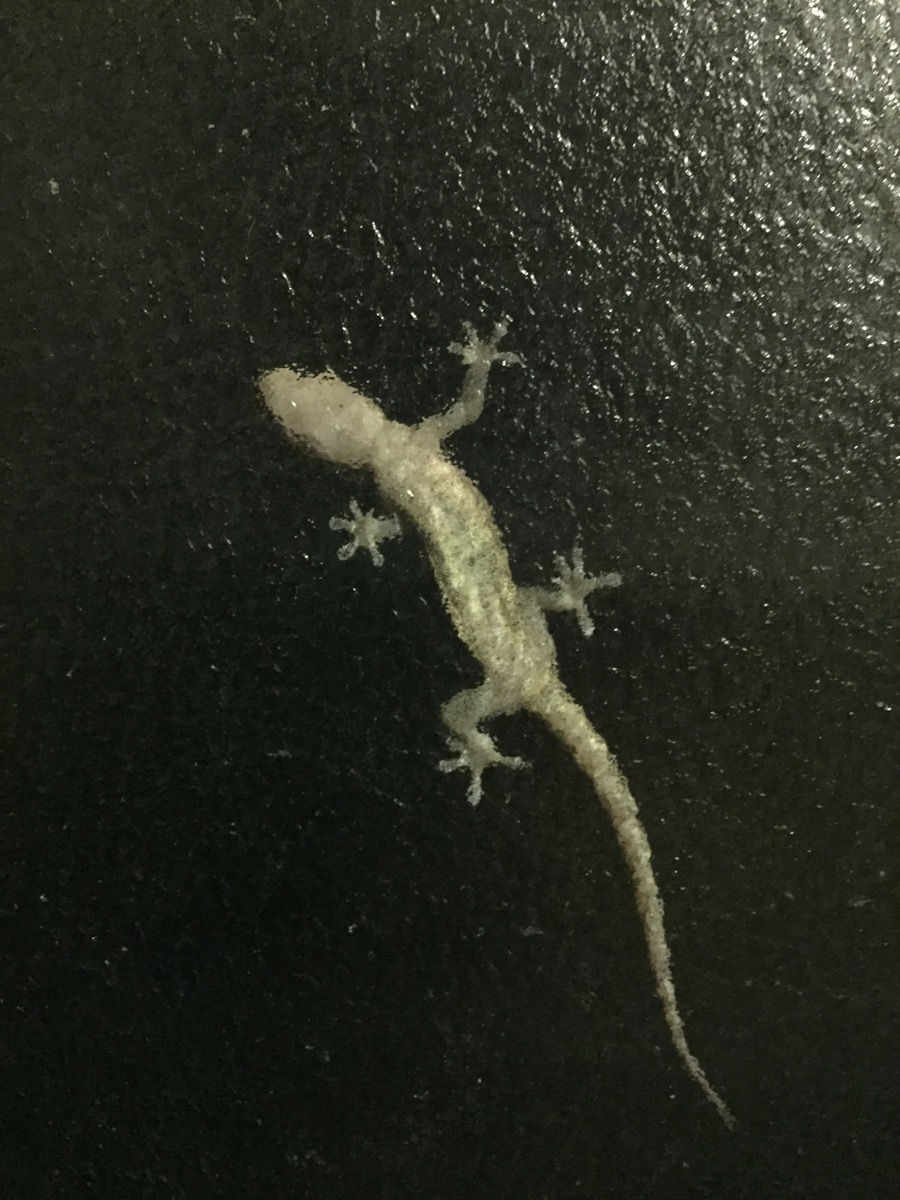
Confession: I really love Asian cafes. They are often so cute, relaxing, and clean. Depending on the type of cafe, sometimes the prices can be a little high, but the ambience is so good.
One of my favorites is a small, hidden book cafe. The name is “Bookish” and it is located in Nishihara, near to the university. It is off a back road, off another back road, and up a hill. Parking is on the first level, and take the stairs up to the second level. Through the set of doors you enter into something that looks like a cross between a library and a quiet restaurant. I often choose the seats at the window bar, overlooking the valley to the Nakagusuku Bay. The menu is pretty simple, some sandwiches, a pasta, pizza toast, fancy coffees and teas, and of course, desserts. The menu is in Japanese (but katakana mostly because they are westernized foods) and no pictures, so I suppose many English speakers might shy away; but with a little patience, it is not too difficult to order, just practice reading katakana. I enjoy getting a vegetable bagel sandwich (it has delicious ume 梅 pickles on it) with a soy chai latte and just clearing my mind of the days busyness.
address: 沖縄県西原町字棚原83-1
Summer is soon arriving! In Okinawa, this will mean the onset of Beach BBQ parties. But it is a bit different than the US and Hawai’i.
All summer long, many of the beaches have pavilions or tents set up for rental. Work groups, social clubs, sports teams, family gatherings, class reunions and any other type of group you can think of will be renting one of these. You can also rent a grill (with propane container and cooking utensils) and buy pre-made BBQ set of meats/fish/veggies to grill, as well as kegs of beer.
Now, when you go to one of these, it is unlikely to be hamburgers and hotdogs, or steaks or sausages; there is no mustard, ketchup, relish or hamburger rolls. Probably no sides of macaroni salad or desserts jello ambrosia salad. But there is almost always beer, either in kegs or coolers, so there is that. Sometimes whiskey and awamori are brought out, but I usually avoid those.
My experience is that 2 or 3 people will man the grill and start cooking yakitori or other skewers, strips of beef or pork, octopus… whatever. Maybe some eel if you are lucky. Once all the meat and fish is cooked, usually someone will get out the flat sheet for the grill and it is time for yakisoba. Yup. Fried noodles are a classic BBQ item. Coming from Hawai’i this is not terribly unusual, so the first time I experienced this, I just rolled with it. But on further reflection, it was not so common at most of the beach BBQs I had been to before.
If you are really lucky, someone might bring a watermelon for suikawari (read more in a previous post).
Anyway, that is a small bit on Okinawa beach BBQs. I will probably update this a bit more with some pictures during the summer when the season is in full swing.
茶房一葉 Sabou Ichiyou, translated means “teahouse one leaf.” It is the name of an adorable tea room and shop in Nanjo, Okinawa. It is kind of my secret spot since- I may have been her only gaijin customer. I found it after searching online where to find mooncakes in Okinawa, which turns out to be a bit scarcer than one would imagine (the irony is that the popularity of mooncakes has now risen, and are a bit easier to find over the last year). I was desperate, and I really wanted mooncakes 月餅 for moon-viewing ceremony. I finally found this place after sifting through results in Japanese, and decided to seek it out.
I plugged the address into my phone and drove off through a rural area of Nanjo. I pulled up to this small place, and it seemed a bit quiet and off by itself. Tentatively, I opened the door and sure enough I was greeted by a gentle looking woman. She seemed very surprised to see a pale foreigner entering, but nonetheless was extraordinarily kind. I explained in poor Japanese that I was seeking out mooncakes for Tsukimi (moon-viewing). She was excited and decided to serve me some green tea and a jelly dessert called youkan 羊羹. It was indeed wonderful. Then she gave me some acerola jam to take home and asked to take a photo with me. She was so sweet and kind.
Later, after actually reading the website more in depth, I realized she very skilled and professional at tea and tea ceremony. Maybe I can convince her to teach me some of her knowledge one day… but I will probably need to be better at Japanese. Hopefully this will motivate me to continue to learn.
address: 沖縄県南城市大里嶺井502-2
So “wine lottery” is not really an official term, but the translation is rather appropriate. Fukubukuro 福袋 means “lucky bag” in Japanese; often this is seen during the New Year Sales at stores. So, wine lucky bag, or wine lottery as I refer to it is when a store sets out a number of sealed paper bags, each with a wine inside, and sells each bag for a set price (for instance 2000円). Now the thing is, they put up a sign with the various wine that could be inside and the number of chances, but it is random luck which you choose! Usually these wines range from the minimum price of the bag and up… sometimes as much as a 20000円 wine could be inside. Basically, it is a lottery… you never lose per se, but sometimes you can win big. I will admit, sometimes I will weigh various bags, or try to feel the bottle shape to help determine what it may be. This has probably never helped, but one time we ended up with a 6000円 bottle of wine, so I was pleased. Obviously, most people will get one of the bottom tier wines, but… some people get lucky. Sometimes stores will even have Awamori lottery (awamori is the local Okinawan liquor).
Anyway, as silly as it seems, I really enjoy this type of thing. It is kinda thrilling not knowing which one you will get up and opening it up when you get home. I admit, I will buy one of these wine lottery bags whenever they are for sale…
節分 Setsubun is a “bean scattering” or “bean throwing” holiday that occurs on February 3rd. Setsubun literally means the division of seasons, the change from winter into spring. There are many rituals involved in Setsubun.
One is bean-scattering, called mame-maki 豆撒き, to prevent evil demons from entering your house; it is believed that the ogres are warded off by beans, the beans will purify/cleanse your home, and that good fortune will then come to your home. According to tradition, if you eat the same number of beans as your age (plus one for luck), you will enjoy a year of good health.
Every year, I buy roasted soy beans (daizu 大豆) from the grocery, though some people also use peanuts. This time of year they are labeled 福豆 fukumame, “lucky beans.” Sometimes they come with cute masks of oni 鬼 (demon) or おかめ okame (homely/plain lady).
While scattering beans inside and outside the house, at the designated oni (usually the father, eldest male, or male born in the current year’s zodiac will wear the oni mask), you are supposed to chant (in Japanese):
鬼は外! oni wa soto! demons (evil) outside!
福は内! fuku wa uchi! luck (fortune) inside!
In Okinawan language, the pronunciation is a bit different…
ウネーフカ! unee-fuka 「鬼は外」
フコーウチ! fukoo-uchi 「福は内」
My oldest dog was designated oni this year because he was born in this year’s zodiac. I don’t know how he felt about me throwing beans at him…
Many elementary schools will hold this ritual, the oni terrorizing the small children; I have seen some of the videos on the local news.
Every year, the temple in my village holds a Setsubun festival (it usually held on Feb 11th, the public holiday, since Feb 3rd is only an observed holiday). It is really pretty entertaining… people bring all sorts of bags, boxes and containers to catch the lucky beans tossed by the lucky men and women born with the same zodiac as the current year. It honestly reminded me of the scene from Spirited Away when No-face was throwing gold at the bath house workers.
Another custom, which comes from western Japan (but has now spread), is eating an eho-maki 恵方巻 (translation is “lucky-direction roll”); it is a fat sushi rolled wrapped in nori, while facing the year’s lucky direction (determined by the zodiac, it is supposed to be the direction that the kami/god lives in). You are supposed to stand, facing the lucky direction with your eyes closed, and eat the roll all at once without pausing! Considering the size of some these… it is quite difficult. But since it is not really traditional in Okinawa, lots of different types of “eho-maki” will make an appearance, including sweet ones, like roll cakes or crepes!
Some families also put up small decorations made up of sardine heads and holly leaves, called hiragi iwashi 柊鰯, at the entrance of the house to ward off bad spirits.
Narita-san Fukusenji (temple) address: 〒901-2403 沖縄県中頭郡中城村字伊舎堂617 https://goo.gl/maps/r1YFXQDMQVE2
Naminoue Shrine 波上宮 in Naha has a large Setsubun festival held on Feb 3rd every year; it is shown on the news: https://goo.gl/maps/sLP2LHodzT92
Gokokuji Shrine 護国神社 also has a Setsubun matsuri: https://goo.gl/maps/KayHk5KVwWo
寿司: sushi
回転: rotator belt, conveyor belt
回転寿司 Kaiten sushi is conveyer belt (rotator) sushi. By no means is this usually high quality, it is sushi for the masses! Entertaining, low-stress, easy for when you do not remember all the Japanese names for things.
In Okinawa, some of these places will be hundred yen sushi plates. 100円 sushi is definitely good for the wallet, but usually not great quality or variety. Hamazushi, Sushiro, and Kura Sushi are examples of 100円 sushi chains in Okinawa. I like Kura Sushi because they have little game you play for every 5 plates is a chance to win a gachapon (capsule toy). Sushiro has a good seasonal menu, and the quality is a little better than the other 100円 chains. And all of these places tend to have kid-friendly and picky-eater friendly types of foods as well.
Some places are better quality sushi-go-round, and tend to have some better variety. Enraku and Yazaemon are probably the better ones I have been to. Again, it is kaiten sushi so it is not going to be super high quality like you would get from a real sushi chef or anything. But that’s okay– sometimes you just want some cheap, filling sushi, not some fancy “Jiro-dreams-of-sushi” experience. Any time you are in Japan, be sure to visit a kaiten sushi joint to watch as the many plates rotate around and are devoured by the patrons.
Most places have a delivery system where you have a touchscreen at your table; if you do not see what you want on the conveyor belt, simply use the touchscreen to place an order. Some places have little trains or boats on the track that will “deliver” it to your eating station. At your eating station, besides a touchscreen, there is usually green tea, small plates, hashi, shoyu, pickled ginger, wasabi, wet naps, etc. Don’t be intimidated and just watch what other patrons do if it is your first time… it is easy once you get the hang of it. When you are finished, there will be a call button on your touchscreen or at your station, the server will come over and tally up your plates for the bill. Almost all of these touch screens have multi-language options as well.
Sushi-go-round chains in Okinawa: (just copy&paste into GoogleMaps to find the closest to you!)
Hamazushi はま寿司
Kura sushi 無添くら寿司
Sushiro スシロー
Enraku 円楽
Yazaemon やざえもん
Gourmet Kaiten Sushi グルメ回転寿司
In my village, on the 4th Sunday of the month there is a small community farmer and fish market. This mostly consists of the older folks with small farms or ones who like to make prepared foods. Sometimes there are special events (like free mozuku or free fish soup). I really like attending this and being able to support my neighbors. The first few times, we were often stared at, but now I think most of them expect to see the foreigner couple show up now.
Everything is really cheap, so we always go and buy some produce. It is an easy bike ride away, so we get our exercise at the same time.
Fu ふ (麩) is wheat gluten, often added to soups. It contains a lot of starch and is usually eaten in exchange for meat, especially in vegetarian temple food. It is also low of calories, low in fat and easy to digest. In Okinawa, it is mostly sold in dried, long tubes and is called 車麩 kurumu fu, although other forms are usually available in most grocery stores. Another bonus: it is CHEAP. So… of course it is popular(ish)!
Many people add it to miso soup to make it more filling.
Fu chanpuru フーチャンプルー is a popular dish in Okinawa. It is just like goya chanpuru, but with fu substituted for goya (or sometimes both are used!). Chanpuru is basically just a stir-fry.
So, when in Okinawa, try some fu. If you order fu chanpuru, don’t be surprised if the server taking you order looks at you funny… I do not think it is very popular with foreigners. We have been asked if we were ordering the correct thing before. Luckily I am able to reassure them that we know what it is and like it.
Bakeries in Okinawa are abundant, as well as in all of Japan. They are often labelled as pan-ya パン屋 (literally, bread shop) or ベーカリー bakery. Although bread and pastry is more of a western thing, the Japanese have embraced it and made it their own.
I am lucky to have so many nearby, sometimes it is difficult to choose. Some people shop at the large chain bakeries in the malls or grocery stores, but I prefer the small neighborhood bakeries, even though their prices may be slightly higher (but really not by much, usually only a few yen). Here are some of the ones I like (with google map links):
Bakery Lulu just opened up near me (less than a week!), but already I am impressed. Both times I have gone was in the morning, right at opening time. Very delicious. Pastries, baguettes, savory breads…
address: 〒901-2424沖縄県中頭郡南上原208-16 https://goo.gl/maps/YRAgxEgJAdT2
One of my all-time favorites is EM bakery Sun Monte, which I mention in another post.
Kinjo bakery in Shuri has both takeout and an all-you-can-eat option! Read about it here.
Hoppepan is located along Rt 34 in Ginowan is also a good choice (but a bit far from me).
address: 〒901-2225沖縄県宜野湾市大謝名3丁目3−7 https://goo.gl/maps/G7FoYJCj9QA2
Amashokubeika 天食米果 is a recent find in Urasoe. It is fabulous, and specializes in more loaf-type breads, different from what you find in most typical Japanese bakeries. It also lists allergens, and makes some speciality breads.
address: 〒901-2132 沖縄県浦添市伊祖1丁目9−12 https://goo.gl/maps/j6sp96aBCt32
Munakatado 宗像堂 is also marvelous, and makes natural yeast breads, as well as offers vegetarian lunch sandwich and soup. You can read more in the linked post.
address: 〒901-2226沖縄県宜野湾市嘉数1−20−2 https://goo.gl/maps/QGtXfMej4bL2
Suien 水円, located in Yomitan is very far away from me, but very impressive. Delicious breads, and the offer lunch sets, vegetarian and vegan.
address: 沖縄県中頭郡読谷村座喜味367 https://goo.gl/maps/9eC9DK56wbB2
Bakery & Cafe Coo is located in Nakijin, a perfect place to stop by when you visit the Nakijin castle ruins (tip: this place is beautiful with sakura, “cherry blossoms,” during early February).
address: 〒905-0428沖縄県国頭郡今帰仁村今泊3313 https://goo.gl/maps/Jf4KYFdh1Lu
Maruyoshi 丸吉 is another amazing find in Urasoe, with a great array of savory and sweet. I am incredibly impressed with this bakery.
address: 〒901-2553 沖縄県浦添市経塚 676 https://goo.gl/maps/hhgRUrccJ712
There are so many more I could add to the list… maybe I will continue to update.
Tempura is fairly easy to make at home, but can be quite messy; I prefer to get it out at shops. So, where can you find the best tempura in Okinawa?
Every local knows the answer is Oujima 奥武島! Oujima (also seen as Ojima) is located in the more southern part of the island, and is a part of Nanjo. It is connected by a bridge. My husband affectionately refers to this island as “tempura island” because there are several tempura shacks selling fried goodness to the many locals and Japanese tourists. **I recently heard a local also refer to this place as tempura island…!
Probably the most famous one (and with good reason) is Nakamoto tempura store 中本てんぷら店. It is located just to the right after you cross the bridge onto Oujima. Golden deliciousness. Try everything, but especially try the 揚げパン age-pan, meaning “fry bread”; you can get white sugar, brown sugar or kinako (roasted soybean powder). Heaven. The second thing I MUST recommend is the もずく mozuku tempura (mozuku is a special type of Okinawa seaweed), since this is a famous specialty product in this area. If they have アーサー asa (another type of Okinawa seaweed) tempura, you should definitely try that, too. Oh, and the best part? It is so cheap!
If you continue a bit further around this teeny-tiny island, you will come to another shack called Ooshiro tempura store 大城てんぷら店. They are also good, but I think Nakamoto gets my vote for number 1. Why not try both? Then you can decide for yourself which is best, since I am by no means the expert.
Once you fill up on tempura, just take a walk around the island (it is very small, just park at the public park) and take in some of the sights. It is not much, but there is some beach and a small temple. In the summer, there is a ハーリー haarii festival and races (haarii, also written in English as haari or hari, are Okinawan dragon boat races).
Okinawa has some unique mochi sweets. These are made differently than Japan mainland mochi; the feeling of eating Okinawa mochi is unique, and I think even mainland Japanese are surprised at the different mochi here.
I wrote previous post on muuchii ムーチー, a type of mochi wrapped in shell ginger leaves.
Another post explains fuchagi ふちゃぎ, a bean-covered mochi eaten during Tsukimi 月見 or “moon-viewing.”
Now I will introduce nantu (nantou) ナントゥー. This is a type of mochi made with miso! It also has brown sugar and peanut paste in it. Yum. It is often made with jimami (じーまーみ or じーまみ, meaning “island peanut”) and covered in sesame seeds. There is a variation using purple sweet potato or taro (called taanmu in uchinaaguchi), as well. It looks simple, but somehow nostalgic I think. These are sold all over the island at mochi shops, grocery stores, and farmers markets… be sure to look for them here in Okinawa!
Kume-jima probably ranks as our #1 trip among the outer islands of Okinawa (so far). Honestly, it was a combination of things, but it was a pretty great trip away from the hustle and bustle of life.
There are 2 ways of getting to Kume-jima: 4 hour ferry ride or 35 minute plane ride. Not going to lie… take the plane, it is so much better. It was about 150$ roundtrip, so yes, it is more expensive, but it is a very short ride. The ferry is cheaper by half, but over 4x the travel time. So… for me, no questions.
After a short plane ride, we arrived and rented a car. There is a tourist map, which points out the major sites; these can be done in a day, but take it slow and enjoy. It is a beautiful island. Some of the sights may not be terribly interesting, but just enjoy the raw beauty of this island. There are some magnificent views and crystal clear water. Check out the tatami rocks that make an interesting pattern on the beach, and look for some sea turtles. Maybe check out the local awamori distillery.
We coincided our trip with the season of ホタル or 蛍, pronounced hotaru meaning “firefly” (month of May). Okay, yes, I planned my entire trip around fireflies! But Kume-jima is home to rare and special fireflies, so it very much worth it! As matter of fact, the mascot for Kume-jima is a firefly! Be sure to visit the firefly museum during the day, and then the park areas (close to water) in the evening when the magical little fireflies come out. It is really special to experience this sort of beauty, once the sun sets and they start flitting about with bursts of light. Also, the guy at the museum is an alumni of Ryukyu Daigaku and speaks some English, so please visit him! He will tell you many interesting facts and explain why fireflies here in Kume-jima are special.
We stayed at Eef Beach Hotel, and while not grand by any means, it was comfortable and close to restaurants, as well as a nice beach to stroll around. There is a supposedly nicer hotel on the airport side of the island, but we chose quaintness over luxury.
For food, well, you better like either shrimp or local Okinawa grub because there is not much else. Kume-jima is known for 海老 (えび or エビ “ebi”), meaning shrimp. It is fresh! My husband ate shrimp for both lunches and dinner we were on the island. You can get it a number of ways; grilled, battered and fried in tempura, cooked in butter… it is a popular food here, so it is highly recommended you try it. Some of the restaurants have English menus and some do not, so take a chance and just stop in, order whatever is recommended that day. Preferably shrimp. I will post some addresses of the best meals we had later.
Taro: this goes by many names here depending on the exact dialect in Okinawan language.
田芋 taimo is Japanese (田 ta means “field”, 芋 or いも imo means “potato”).
ターンム taanmu, or ターム taamu, are the most common Okinawan variations you will see/hear on the main island (however, there are others).
Coming from Hawai’i, I know a few things to do with taro (re: poi!). That being said, I like to try local recipes, too. One popular way to eat taro here is to boil and mash it with some sugar (this is called “dengaku” デンガク, 田楽). Many Okinawans say it reminds them of grandma’s cooking to eat it this way. Just as an FYI, many farmer’s markets will sell taro already cooked.
Interestingly enough, you may also see some labeled チンヌク chinnuku here in Okinawa, another type of taro. From my understanding, there are 2 types of taro in Okinawa, taanmu is cultivated in a shallow water field, and chinnuku is in a regular field. Taanmu is supposed to be better for sweet things, and chinnuku used for things like ジューシー juushii (cooked rice meals). But honestly, you can probably use them fairly interchangeably…
If you like taro, try some of the delicious Okinawa treats made with it:



